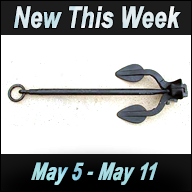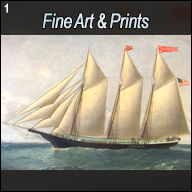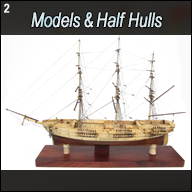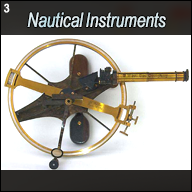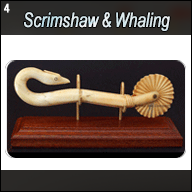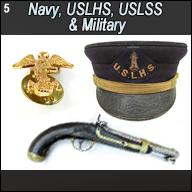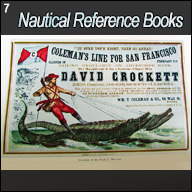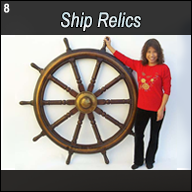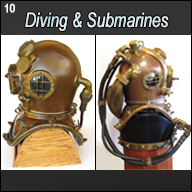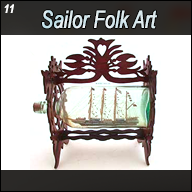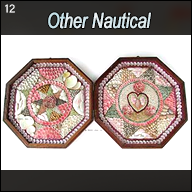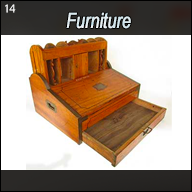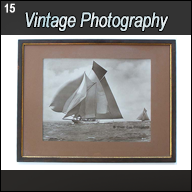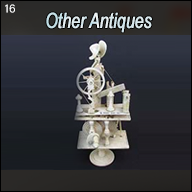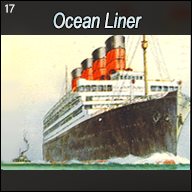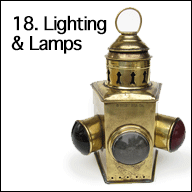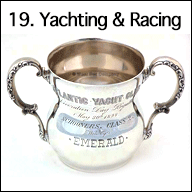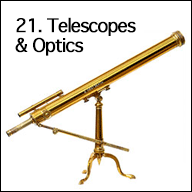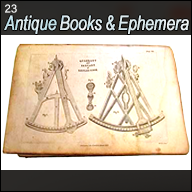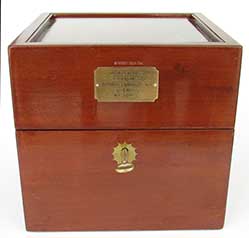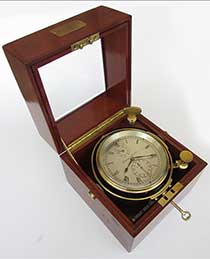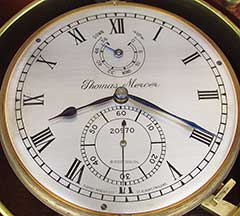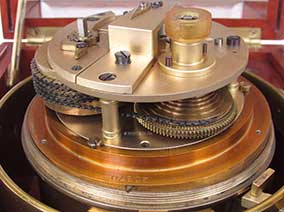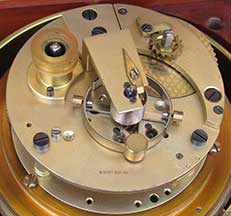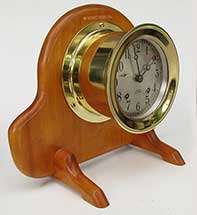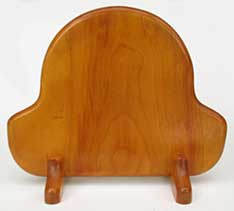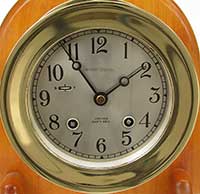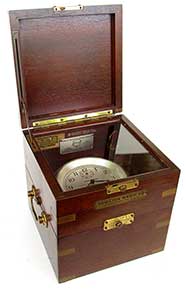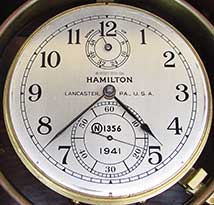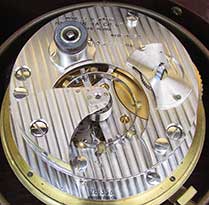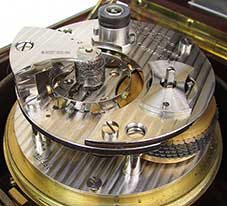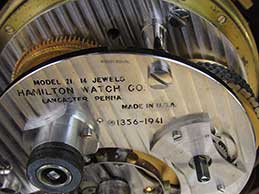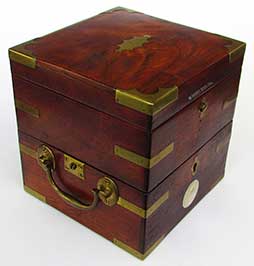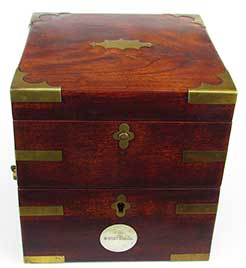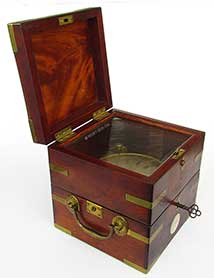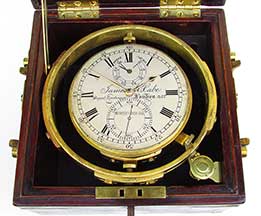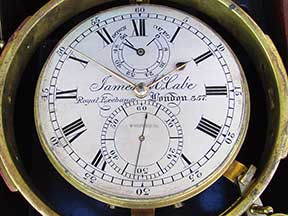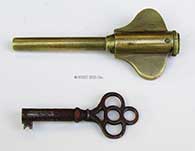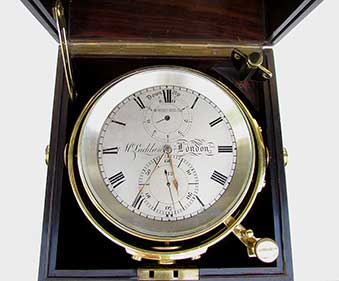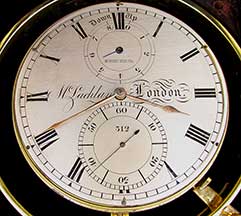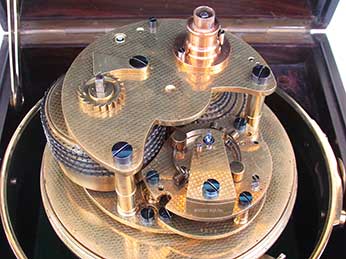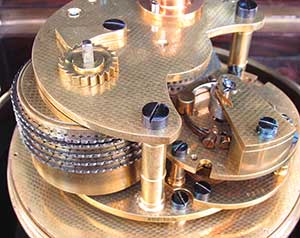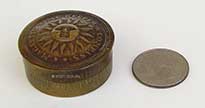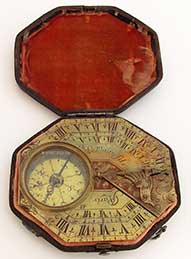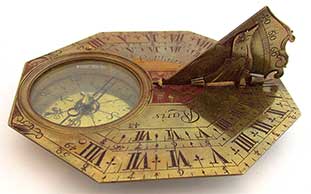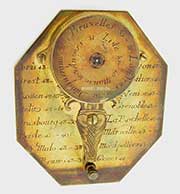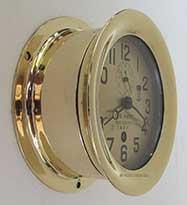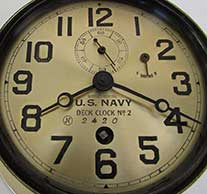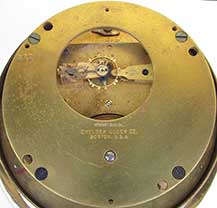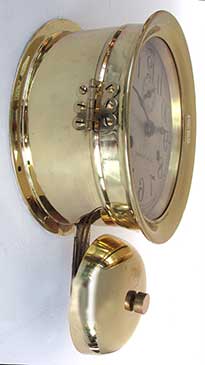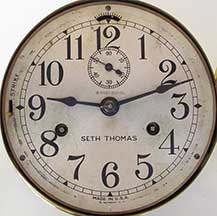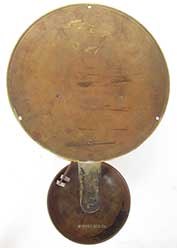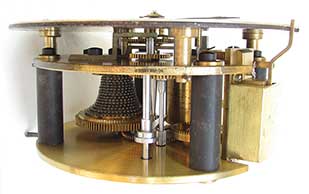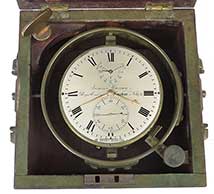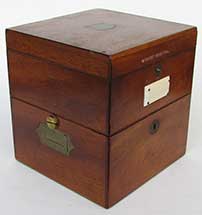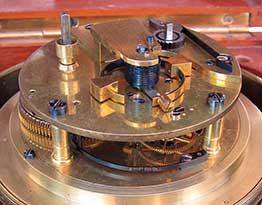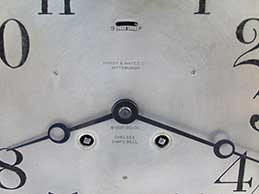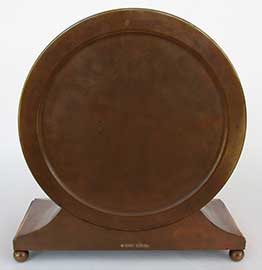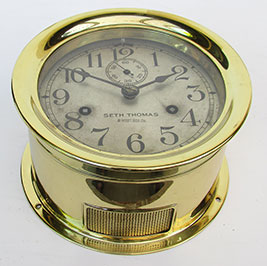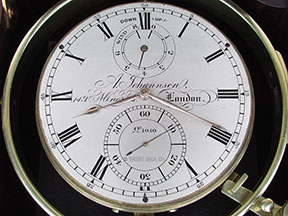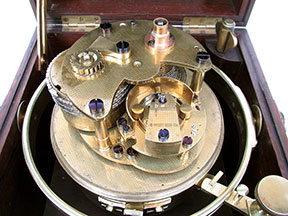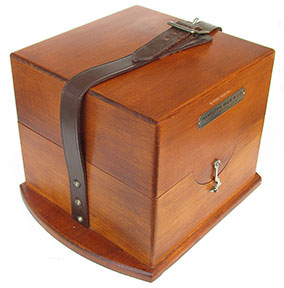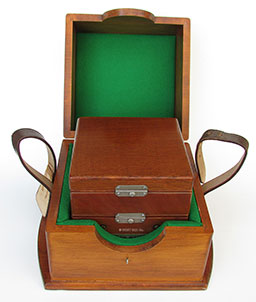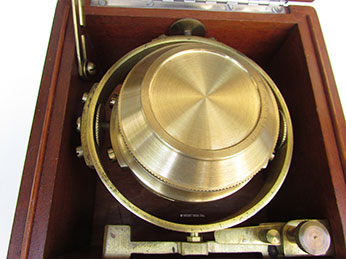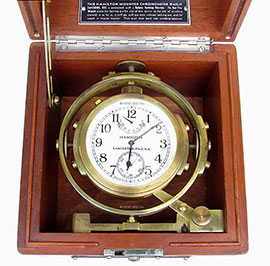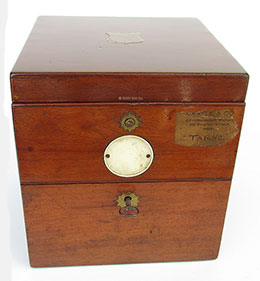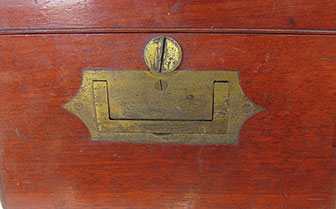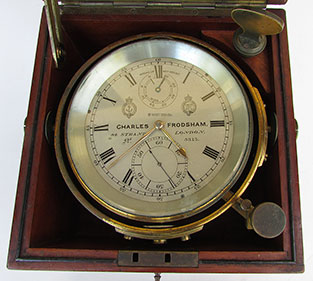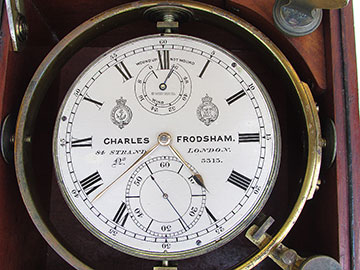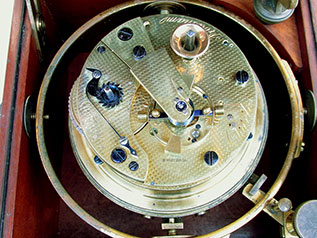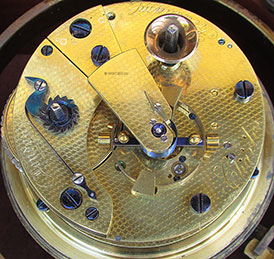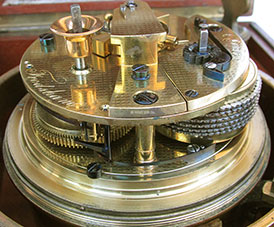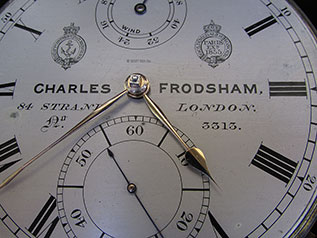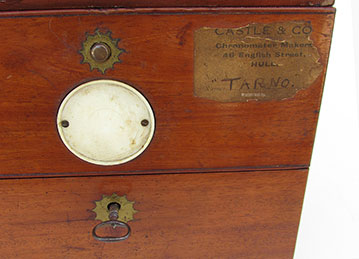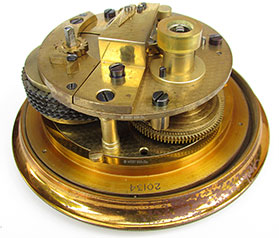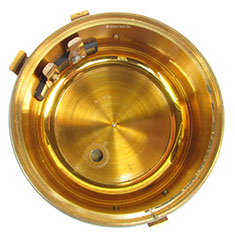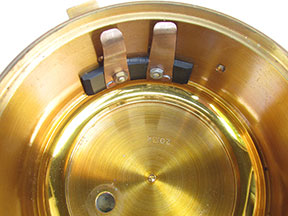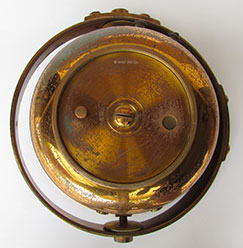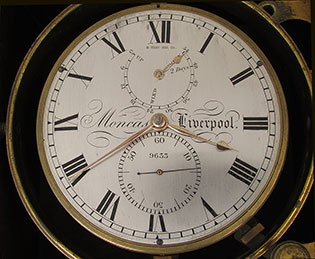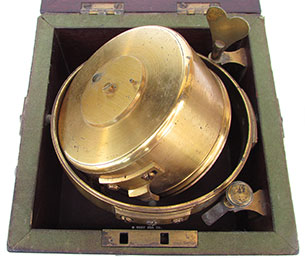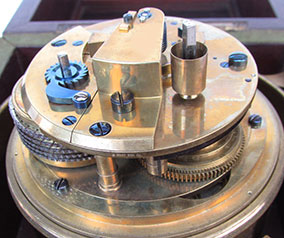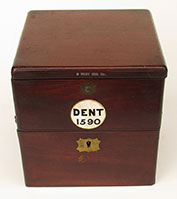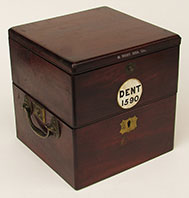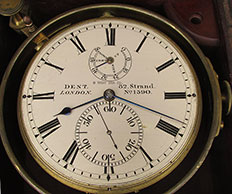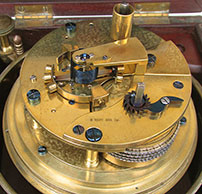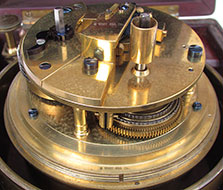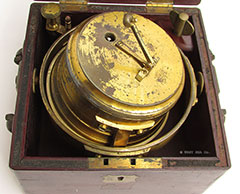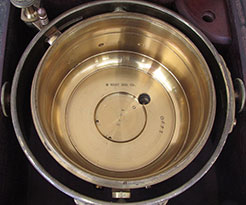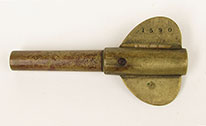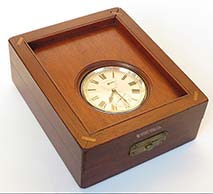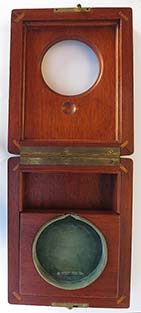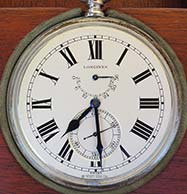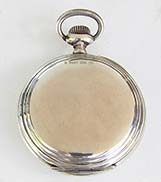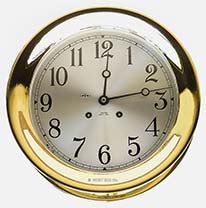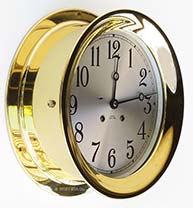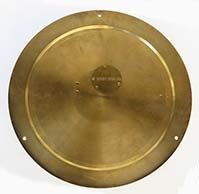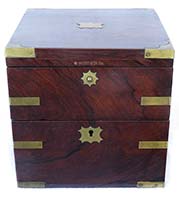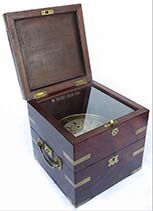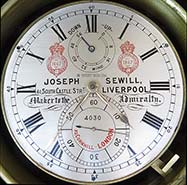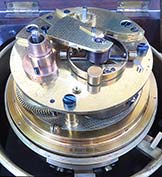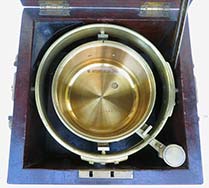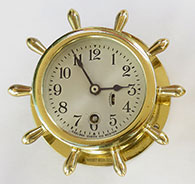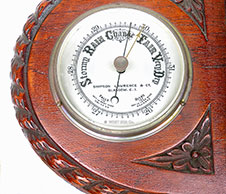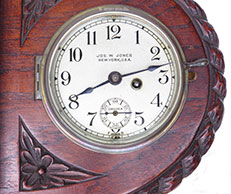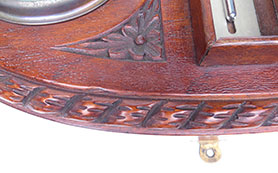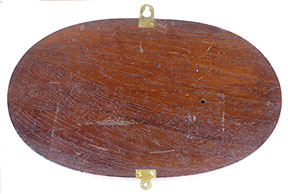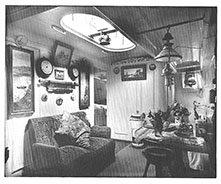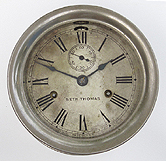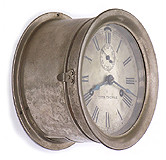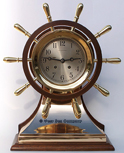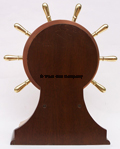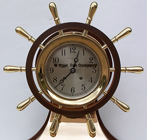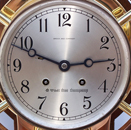13. Clocks & Chronometers
Prices in U.S. Dollars are in GREEN
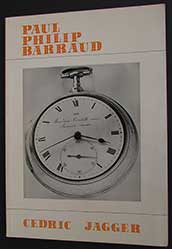 |
13.40 CHRONOMETER REFERENCE BOOK. Cedric Jagger, “Paul Philip Barraud” pioneer chronometer maker. A study of a fine Chronometer Maker and his Successors 1750-1929. 1968, The Antiquarian Horological Society, London. Soft cover, 164 glossy pages exclusive of index. Nicely illustrated in black and white with detailed photographs of clocks, watches and chronometer. There is a full biographical history of Barraud, his working family members and his business associates. Of great significance is the extensive section documenting Barraud chronometers, watches and clocks with serial numbers, dates, descriptions and individual histories. Excellent condition throughout. An absolute must for the proud lucky owner of a Barraud timepiece. 49 |
 |
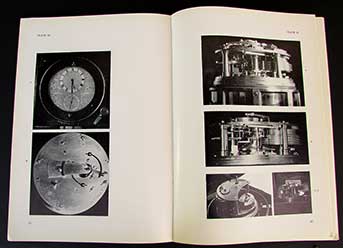 |
| plate 1 | plate 2 |
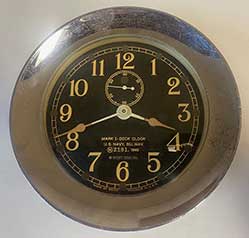 |
5.38/13.14 EARLY NAVY DECK CLOCK. Most impressive pre-war U.S. Navy clock made by the renowned American clock maker Seth Thomas as marked on the bottom of the dial “MADE BY SETH THOMAS IN U.S.A.” This massive clock has a blackened brass dial with Arabic numerals, a minute chapter and luminescent spade hands. The subsidiary seconds bit is below the 12, calibrated in single seconds marked by 10’s. The signature reads “MARK I DECK CLOCK, U.S. NAVY, BU.NAV. (N) 2191, 1940.” This indicates it was made at least a year and a half prior to America’s entry into World War II at the end of December 1941! The high quality movement met the very demanding specifications of the government at that time. It consists of an all brass, 11 jewel movement with compensated lever escapement which functions regardless of temperature and atmospheric conditions. The backplate of the movement is stamped “MADE IN (<ST>) U.S.A.” with the model number “5180.” Undoubtedly, this is one of the finest quality mechanical clocks ever made, at a time when the fate of America was on the line! The 5 ¾ inch dial is encompassed by its silvered reflector ring set in the nickeled brass bezel with convex crystal. The flared bezel is classic. It is solid brass in a nickel finish, hinged on the left, opening on the right with a pivoting wing nut. The amazing over-built brass case measures 8 ¼ inches on the mounting flange and 7 ¼ inches in diameter on the bezel. The opening to the face is 5 5/8 inches. The entire unit weighs an astounding 10+ pounds! Overall condition is excellent. There is some expected age spotting to the finish, mainly on the bezel flange. But this is entirely consistent with its age and actual use in a combat environment. The clock is an excellent timekeeper. Complete with period brass winding key. 895 In his landmark reference book, Marvin Whitney, “Military Timepieces,” 1992, American Watchmaker’s Institute, states on page 429 that Seth Thomas boat and deck clocks (Mark I) were constructed in accordance with U.S. Navy Department specifications of 1938. They consisted of an 8-day movement housed in a metal case which was dust-proof and moisture-proof. It was equipped with a cushioned bulkhead mounting plate with a lusterless black 12-hour dial with luminous hand and dots over the numerals. Each had an eccentric second hand. The clocks were designed to be wound and set and regulated through a dust cover on back of the case. The model number was stamped on the backplate. In this case it is No. 5180. |
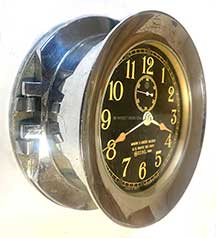 |
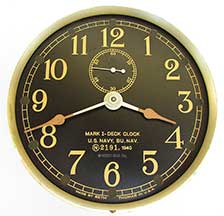 |
| perspective | dial |
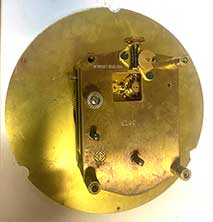 |
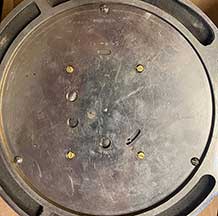 |
| movement | back |
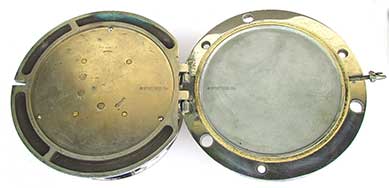 |
| backs |
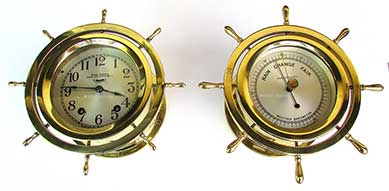 |
13.15 SHIP’s BELL CLOCK & BAROMETER. Classic, early 1900’s American ship’s clock and barometer set. This matching pair was manufactured by the famous Seth Thomas Company of Thomaston, Connecticut as marked on the bottom of the clock dial “MADE BY SETH THOMAS IN U.S.A.” It is further marked above the center arbor “SEVEN JEWELED EIGHT DAY SHIP’S BELL.” The silvered brass dial has bold Arabic numerals and a minute chapter swept by blued steel spade hands. The fast/slow lever adjustment is just above the center arbor. The back of the all brass movement is stamped with the Seth Thomas trademark “<ST> MADE IN U.S.A.” It is further marked “Patented October. 25. 1921” Then, “Seth Thomas, Thomaston, CONN, 115A.” The matching barometer was made by the equally famous instrument company as marked on the bottom of the barometer dial “MADE BY TAYOLOR INSTRUMENT COS., ROCHESTER, N.Y.” Its silvered brass dial is calibrated in inches of mercury atmospheric pressure from 25 to 31 divided in 2/100th increments marked in tenths. It boldly reads RAIN, CHANGE and FAIR. Below it is marked “Compensated Weather Barometer.” The back is stamped “MAYFLOWER.” Both the clock and barometer have 4 inch dials with glass crystals. Their bezels measure 5 ¼ inches across. The outer rims of the unique ship’s wheel format measure 6 ½ inches. The 8 spoke ship’s wheels are 8 1/8 and 8 ¾ inches respectively. The mounting flanges of each are 5 ¾ inches in diameter. Overall condition is absolutely outstanding with both cases in a lustrous high polished brass finish. The clock was just recently overhauled. It is an excellent time keeper and strikes the ship’s bells sequence properly with a pleasant sonorous tone. Complete with period brass winding key. The matching barometer is lively and accurate, compete with knurled brass knob and set needle. A most handsome, quality maritime pair approximately 100 years old! |
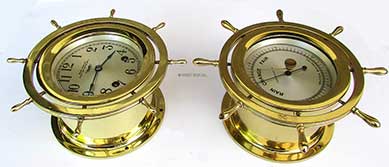 |
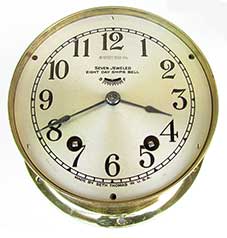 |
| perspective | clock |
 |
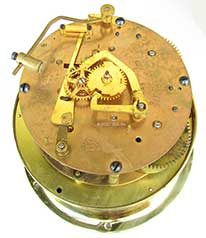 |
| barometer | movement |
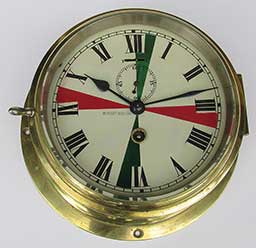 |
13.13 RADIO ROOM CLOCK. World War II or earlier merchant ship’s Marconi clock marked “SWISS MADE” in tiny letters on the dial below the VI. The all brass movement is stamped “BUREN SWISS MADE” in an oval on the back plate. This high quality 7 jewel clock with lever escapement has a white enameled dial with bold Roman numerals and a minute chapter swept by beautifully blued steel spade hands. It has a subsidiary seconds bit below the XII which indicates single seconds marked in quarters. The Fast/Slow lever adjustment is just above. Unique to this clock, adding to its value and appeal, are the colorful red and green sectors on the dial which indicate the times in which the radio operator should listen for distress calls in Morse Code (red), and when radio telegraphy could be used for the same purpose (green). The handsome 6 inch dial is mounted in its original solid brass clock case with hinged bezel on the right opening on the left with a press fit. The heavy cast brass bezel has a silvered reflector ring protected by a thick beveled glass crystal. For ease of opening a small contoured lever is provided on the left. This classic maritime clock case has a mounting flange with 4 screws and measures 8 1/8 inches in diameter. The case is 3 ½ inches deep. This clock has just been professionally serviced by a certified watchmaker and is in tip top running condition. Complete with period brass winding key. 549 Büren an der Aare is a small Renaissance village in northwestern Switzerland, known for more than two centuries for its production of high quality clock and watches. Maritime communication using Morse code gave way to oral radio transmission after World War I. Clocks of this type were soon rendered obsolete. But now, years later, many modern clock companies are capitalizing on marketing reproductions of this colorful nostalgia. This clock is original, from the period! |
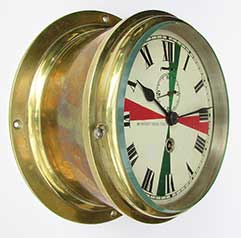 |
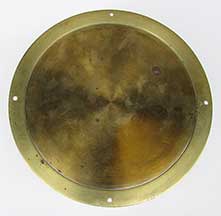 |
| perspective | back |
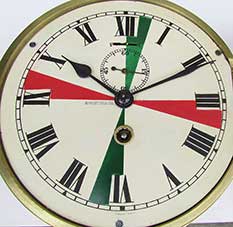 |
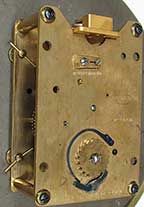 |
| dial | movement |
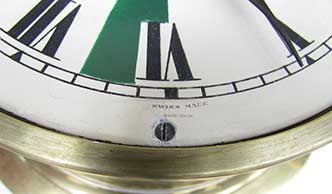 |
 |
| swiss made | maker |
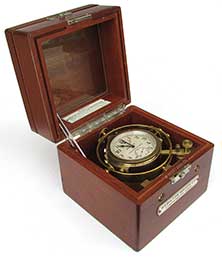 |
5.33/13.11 WORLD WAR II DECK WATCH. The famous navigational chronometer watch made for the U.S. Navy by the prestigious Hamilton Watch Company of Lancaster, Pennsylvania. This iconic timekeeper consists of Hamilton’s innovative Model 22 embodied in an oversized 35 size watch set in a very heavy solid brass case with weighted bottom. Billed as a “chronometer watch” this marvel of precision timekeeping is technically not a “true chronometer.” But what was done to elevate its timekeeping ability to that high status is remarkable. Instead of having a spring détente chronometer escapement, it has a standard watch balance known as a “lever escapement.” To maintain consistent power it contains an oversize main spring 60 inches in length! The innovative biaxial thermal expansion balance is fitted with an Elinvar hairspring unaffected by temperature changes. What’s more, this new innovation was non-magnetic! The lovely damascened nickeled brass movement is signed “HAMILTON WATCH CO. MODEL 22 – 21 JEWELS ADJ. TO TEMP. & 6 POS. MADE IN U.S.A. U.S. NAVY BU. SHIPS – 1943. It features a white enameled dial with bold Arabic numerals swept by blued steel spade hands and a minute chapter ring. A subsidiary seconds bit records single seconds marked by 10’s over the “6.” The intricate Up/Down winding indicator is below the “12.” It shows the status of winding in hours from 56 DOWN to 0 UP. This watch is stem wound and pin set. The latter is a high grade cautionary feature which prevents the time from being accidentally set during winding. Serial numbers on the bezel, on the side of the case and on the weighted brass bottom all match. The entire assembly is slung in gimbals and is mounted in its original 3-tier mahogany box with 2 original nameplates. The box measures 6 inches cubed. The overall condition is outstanding throughout. The watch itself is an excellent timekeeper. Price Request After Japan attacked Pearl Harbor, Hawaii in late 1941 America entered World War II. The Hamilton Watch Company met the navigational challenge with its famous Hamilton Model 21 and 22 chronometers. Amazingly, it produced more than 10,000 of each model to the highest standards demanded by the government. This is one of those heroic survivors which has now lasted 80 years and is still going strong! |
 |
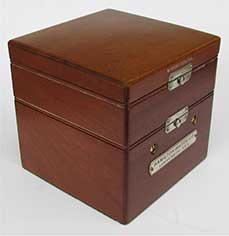 |
| front | perspective |
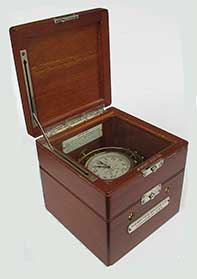 |
 |
| open | detail |
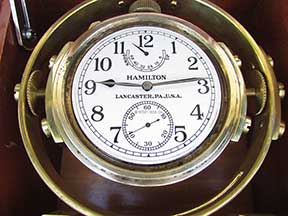 |
 |
| dial | movement |
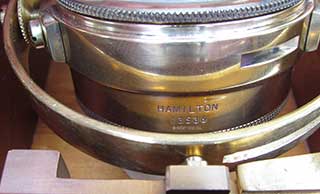 |
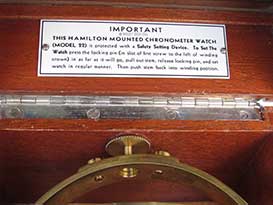 |
| hamilton | plaque |
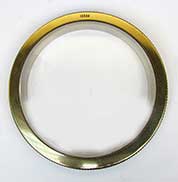 |
| bezel number |
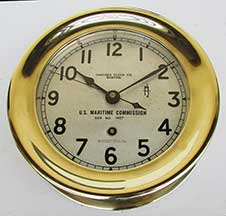 |
5.34/13.12 IMPRESSIVE WWII CLOCK. One of the finest ship’s clocks ever made, this handsome example is by the prestigious Chelsea Clock Company of Boston Massachusetts as clearly signed on the dial “CHELSEA CLOCK CO. BOSTON” below the 12. This high quality timepiece has a silvered brass dial with large Arabic numerals and a minute chapter ring swept by blackened spade hands. In a rare departure from its standard models up to that time, and in keeping with Government specifications, it bears a center sweep second hand. Under the center arbor it is boldly marked “U.S. MARITIME COMMISSION Ser. No. 1407.” The clock retains its silvered dial reflector ring, protected by the screw-on bezel with original glass and rarely-found snap ring. The all brass jeweled movement is a thing of beauty and is stamped on the backplate “CHELSEA CLOCK CO. BOSTON U.S.A. with the serial number “306XXX*” dating its production to April 1942, just 4 months after America’s entry into the War. It is housed in its original heavy solid brass case of flared classical clock case design. The screw on bezel assures an air tight fit. That back of the clock is stamped with the matching movement number “306XXX*.” Outstanding original condition in all respects. The clock has just been professionally service by a certified watch maker and keeps perfect time. It also comes with a one year warranty! 650 A nearly identical, but later clock sold in August 2023 for $819. https://www.eldreds.com/auction-lot/chelsea-ships-clock-20th-century-bezel-diameter-7_D604EBAA6B In his landmark work “Military Timepieces” by Marvin Whitney, 1992, American Watchmakers Institute Press, the author indicates that the Chelsea “Radio Room” clock became a standard inventory item in the early months of 1941 when the Navy and Maritime Commission included it in their mechanical clock specifications. This was Chelsea’s model 12E with an 11 jewel 8 day movement made in accordance with U.S. Navy Department Specifications dated September 1, 1938. *For the privacy of the buyer the entire serial number is being withheld.
The United State Maritime Commission was an independent executive agency of the U.S. federal government created by the Merchant Marine Act of 1936. It replaced the United States Shipping Board which had existed since World War I. Its purpose was to establish a merchant shipbuilding program to design and build five hundred modern merchant cargo ships to replace the World War I vintage vessels which composed most of the United States Merchant Marine at the time. Secondly, to subsidize the building of those ships in the U.S. and operate them under the American flag. From 1939 through the end of World War II, the Maritime Commission funded and administered the largest and most successful merchant shipping in world history. By the end of the war, U.S. shipyards working under U.S. Maritime Commission contracts had built a total of 5,777 oceangoing merchant and naval ships and many smaller vessels! The U.S. Maritime Commission was disbanded on May 24, 1950. |
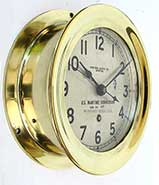 |
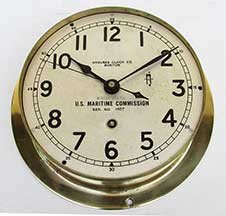 |
| perspective | dial |
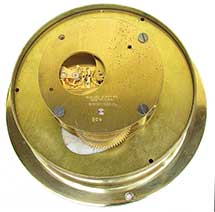 |
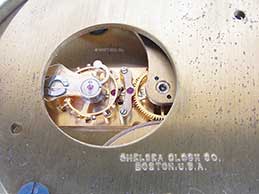 |
| movement | escapement |
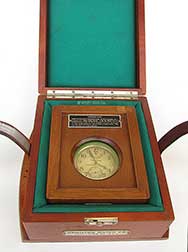 |
5.32/13.10 CELEBRATED PT BOAT WATCH. The iconic World War II U.S. Navy deck watch made even more famous by JFK’s PT-109. Incredibly, it was produced under the most demanding and trying times when America just entered the war. Billed as a “chronometer watch” this marvel of precision timekeeping is technically not a “true” chronometer. But what was done to elevate its timekeeping ability to that high status is remarkable. Instead of having a spring détente, it has a standard watch balance known as a “lever escapement.” Hamilton, already known for its production of top quality pocket and wrist watches, stepped up to the plate in the tumultuous months leading up the nation’s active involvement. This fabulous example marks a high point in the company’s long history of producing quality timepieces. It is embodied in a large 35 size pocket watch with white enameled dial. The high grade 21 jewel movement contains an oversize main spring 60 inches in length! The innovative biaxial thermal expansion balance is fitted with an Elinvar hairspring unaffected by temperature changes. What’s more, this new innovation was non-magnetic! The bold Arabic numerals are swept by blued steel spade hands within a minute chapter ring. A subsidiary seconds bit recording single seconds marked by 10’s is over the “6.” The quality Up/Down winding indicator is below the “12.” It shows the status of winding in hours from 56 DOWN to 0 UP. This watch is stem wound and pin set. The latter cautionary feature prevents the watch from being accidentally set during winding. The back of the watch has a screw-on cover. Inside it is marked “KEYSTONE Base Metal” with the company’s trademark. An inner snap-fit cover further protects the precious movement. The highly damascened nickel plates are a thing of beauty. With its state-of-the-art compensated balance it is literally an Horological work of art! The top plate is marked “HAMILTON WATCH CO. MODEL 22 -21 JEWELS ADJ. TO TEMP. & 6 POS. MADE IN U.S.A. U.S. NAVY BU-SHIPS. 1942.” The watch itself measures 2 3/4 inches in diameter and is 3 3/8 inches high inclusive of the winding stem (pendant). It is housed in its inner padded mahogany box measuring 6 by 5 by 2 inches with viewing window. The box is hinged at the back and closes securely with a button latch. It is further protected within its outer carrying/mounting box constructed of rich cherrywood. It bears the maker’s nameplate reading “HAMILTON WATCH CO. Lancaster, PA. U.S.A.” The hinged box measures 8 ¼ by 9 inches at the widest and 5 1/8 inch thick. It has another button latch for closure and a leather belt for carrying. The entire presentation is in a truly remarkable state of original preservation after 81 years! The perfect watch is an excellent timekeeper -- to the second! Price Request At the time of this posting a similar watch in much poorer condition is listed on eBay for $1,600. In his landmark reference book “The Ship’s Chronometer,” author Marvin Whitney remarks on page 201 “This 36 size, high-quality, 21 jeweled movement is an instrument of great beauty, precision and endurance. Anyone owning one of these fine chronometers has every reason to be proud of this possession.” |
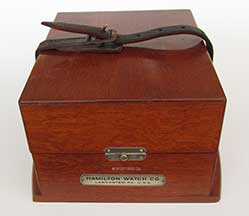 |
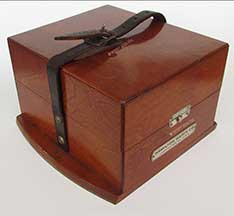 |
| outer box | outer box perspective |
 |
 |
| in case | in case 2 |
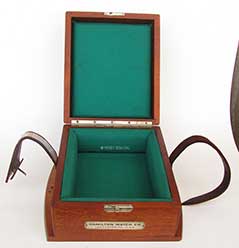 |
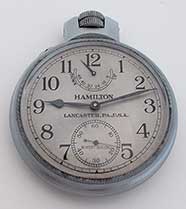 |
| outer box open | Watch |
 |
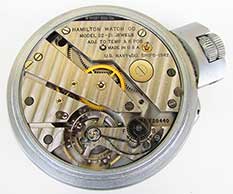 |
| covers | movement |
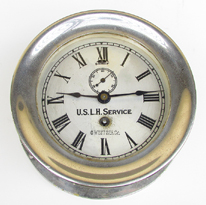 |
5.22/13.09 U.S. LIGHTHOUSE SERVICE CLOCK. Genuine, early 1900’s clock from an identified lighthouse! This handsome little clock was made by the prestigious Chelsea Clock Company of Boston, Massachusetts and is marked “CHELSEA BOSTON” at the bottom of the silvered brass dial. The dial is encircled by a minute chapter ring and is marked with bold Roman numerals swept by blued steel spade hands. The Fast/Slow adjustment and the subsidiary seconds bit are below the XII. The bit shows single seconds marked in increments of 10. The clock retains its original silvered reflector ring covering the periphery of the dial. The high quality jeweled movement is marked “BOSTON CLOCK CO. BOSTON U.S.A. with the serial number 278XX B*. This is Chelsea’s innovative Boston movement which featured a miniaturized 7 jewel timekeeper with non-corrosive nickel plates. It is mounted in its very heavy nickel-plated brass case with classic flared screw-on bezel containing its original wavy crystal glass and retaining wire. The back of the case is stamped with the matching movement number “278XX.”* The clock measures 5 5/8 inches in diameter and is 2 ½ inches deep. Outstanding original condition keeping excellent time after more than 90 years. Complete with original old “bat wing” Chelsea winding key. Price Request * For the privacy of the ultimate owner the complete serial number is being withheld. According to Andy Demeter in his groundbreaking reference book “Chelsea Clock Company, The First Hundred Years,“ 2001, Demeter Publications, Chelsea, Massachusetts, the Chelsea Company produced Boston Clock movements from about 1914 through 1930 and dated this clock to circa May 10, 1922. But in his 2nd Edition Demeter indicates this exact clock, serial “278XXB,” was delivered to the U.S. Lighthouse Service on July 29, 1932. We cannot account for the discrepancy in dates, but the 10 year timeframe is certainly consistent with the date of the Lighthouse Service and the lighthouse in which it served. According to the party from whom we acquired this clock, it came from an old Bellingham, Washington estate. Ships heading from Bellingham Bay through the Straits of Juan de Fuca passed Burrows Island, where strong eddies and rip tides made passage unpredictable. In 1897 the Lighthouse Board noted that vessel traffic through the Strait was increasing. In response to the need it requested $15,000 to build a light and fog signal on the south west point of Burrows Island -- a point of departure for vessels plying the strait. Congress approved construction of the Burrows Island Lighthouse in 1903. The shoreline of Burrows Island is primarily sheer steep rock. Steep hills covered with evergreens and grass cover much of its interior. The light station was built on one of the few level spots on the island’s shoreline. Work began in May 1905 and the wooden frame lighthouse was first lighted on April 1, 1906. It had a white light with a red sector shown from a 4th order Freznel lens The station originally included the combination light tower and fog signal building, the keeper's quarters, oil house, a boathouse and a derrick. Burrows Island Lighthouse was automated in 1972 when the final Coast Guard personnel left the station. The boathouse and keeper's dwelling were boarded up and a fence erected. In the early 1990's a modern optic replaced the Freznel lens in the lantern room. Today the complex is still standing as an historical site. During its service as the Burrows Island Lighthouse the keepers were: James B. Hermann (1906), Eugene M. Walters (1907), Edward Pfaff (1907), William J. Thomas (1907 – 1913), Thomas J. Stitt (1913 – 1920), William Dahlgren (1920 – at least 1921), Daniel W. Clark (1924 – 1931), Robert R. Bay (1931 – 1932), John T. O’Rourke (1932 – 1943), Richard Johnson (1960 – 1963), Frank Showers (at least 1966), David J. Grotting (1969 – 1972). In 1789 Congress passed an Act creating the United States Lighthouse Establishment (USLHE) which was operated by the Department of the Treasury. The Act also transferred ownership of all existing private American lighthouses to the U.S. government. In 1852, the United States Lighthouse Board was created. The Act dissolved the prior administration of lighthouses under the Treasury Department's Lighthouse Establishment. The board consisted of six senior Naval officers governing 12 lighthouse districts, each having a Naval inspector who was charged with building lighthouses and maintaining their good working order. The Lighthouse Board immediately set to installing state-of-the-art Freznel lenses in all newly-built lighthouses. The Board also oversaw the construction of the first lighthouses on the West Coast. By the Civil War, all U.S. lighthouses had Freznel lenses. In 1886, electricity was tested to illuminate the Statue of Liberty. Thereafter the lighting of the statue was the Lighthouse Board's responsibility. It remained such until 1902, when the "modern age in lighthouse illumination" began. In 1900, the Lighthouse Board started converting lighthouses to electric service. In 1910, the Board was changed in favor of a civilian run "Lighthouse Service." It is uncertain as to exactly when the U.S. Lighthouse Establishment became the U.S. Lighthouse Service. Both terms for the agency appear to have been used interchangeably in the second half of the 19th century. In 1939 the U.S. Lighthouse Service itself was disbanded and merged with the U.S. Coast Guard. |
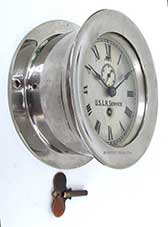 |
 |
| perspective | dial |
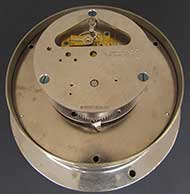 |
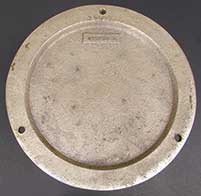 |
| movement | back |
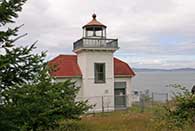 |
| lighthouse |
 |
13.06 VINTAGE SHIP’s BELL CLOCK. Authentic World War II era ship’s bell clock made by the prestigious Chelsea Clock Company of Boston, Massachusetts. Known for their highest quality, this fine example with matching serial numbers 473XXX* dates to 1944. It has a 6 inch silvered brass dial with bold Arabic numerals and minute chapter swept by classic blued steel Breguet moon hands. Chelsea’s older style lever Fast/Slow adjustment is below the “12.” Of great desirability is the fact that this clock has a convenient hinged bezel opening on the left with a thumbscrew lock. The the bezel of this clock is Bakelite and the case is zinc, indicative of its unique production due to the shortage of brass during WWII. Incredibly it still weighs over 8 pounds! It measures 7 ¾ inches in diameter by 3 ¼ inches thick. This quality clock was just professionally serviced at a cost of $200 (trade price). Now it keeps excellent time, striking the ship’s bell sequence properly with a very pleasing tone. One year warranty. Complete with period winding key. Please, try to find a better deal. 895 Current market value for a fully functional Chelsea ship’s bell striking clock over 75 years is at least $1500. * For the privacy of the buyer, the full serial number of this clock is being withheld. |
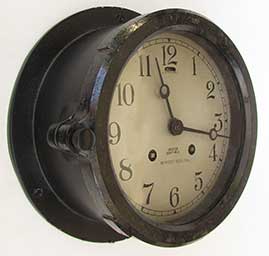 |
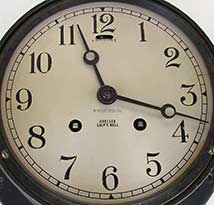 |
| perspective | dial |
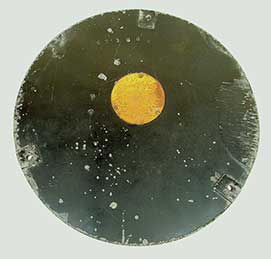 |
| back |
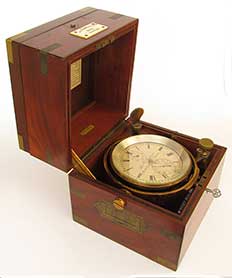 |
13.07 AMERICAN CHRONOMETER. Excellent turn-of-the-1900’s ship’s 2-day navigational timekeeper with the dial engraved in fancy cursive script “Thos G. Medinger.” Then in Gothic script “New York No. 1001.” This especially handsome chronometer has a silvered brass dial with bold Roman numerals a minute chapter ring swept by solid gold spade hands. The large seconds bit covers the VI which shows single seconds marked by 10’s. At the top of the dial, below the XII, is the Up/Down indicator running from 0 - 56 in 8 hour increments. The dial is complete with its silvered reflector ring covered by the knurled brass bezel with beveled glass crystal. It is set in its heavy turned brass bowl with rotating dust cover on the bottom for winding. The all brass movement is the finest quality of its time, being made by the famous award winning maker Victor Kullberg. It has damascened brass plates, beautiful blued steel screws, large balance with temperature compensation, diamond end stone, spring détente escapement, and of course Kullberg’s signature reverse chain-drive fusee. The bottom of the bowl is stamped with Kullberg’s number 8478 which dates to 1911. The chronometer and bowl are slung in gimbals in their classic brass bound solid mahogany box. In our experience, the overall presentation is particularly handsome. The box itself is in near pristine original condition after more than 100 years! In addition, it retains 3 more valuable features. The front bears the engraved ivory label reading “THOS. MEDINGER 1001 NEW YORK.” Then in the lid is the trade label of “Eugene F. Medinger, New York.” And the middle tier bears the label of the famous American nautical company “John Bliss & Co., New York.” The sides of the box have inlaid folding brass handles. It is complete with its original ratcheted winding key and rarely found original box lock skeleton key. The bezel measures 4 7/8 inches in diameter. The box is 7 ¼ inches square by 7 ¾ inches high. Condition is just about as nice as any we have seen in our 40+ years of doing this business. A real winner! Price Request Victor Kullberg (1824-1890). According to Mercer in “Chronometer Makers of the World, “ His workmanship was without doubt of the highest quality. He supplied many retailers and nautical opticians with complete movements.” Kullberg was awarded medals at Sydney, Paris, Le Harve, Philadelphia, London and Scotland, including 9 gold medals, the Cross of Legion of Honour in Vienna and the Grand Prix in Paris. Kullberg chronometers finished first in the annual Greenwich Observatory trials an amazing 24 times beginning in 1864 through 1914 when the trials were ended. Kullberg 8472 took the prize in 1913. |
 |
 |
| perspective | front |
 |
 |
| open | in box |
 |
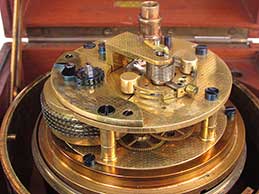 |
| dial | movement |
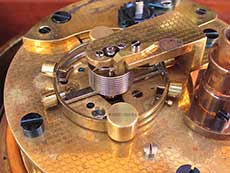 |
 |
| balance | label |
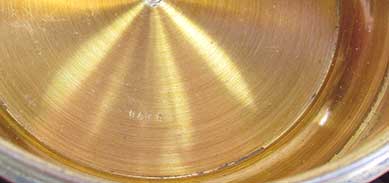 |
| 8748 |
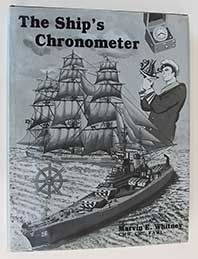 |
7.87/13.81 REFERENCE BOOK "The SHIP's CHRONOMETER." Marvin Whitney. "The Ship's Chronometer," 1985, The American Watchmaker's Press, Cincinnati, Ohio. Hard cloth cover with dust jacket, 474 glossy pages exclusive of index. Exquisitely illustrated with photographs, detailed line drawings and charts. Mr. Whitney, who served his apprenticeship and the United State Naval Observatory before and into World War II, is recognized as the foremost American expert on chronometers in the 20th century. This large format book has chapters on "The Birth of Chronometers, Transporting, Handling and Cleaning, The English Escapement, General Repairs, The Navigating Chronometer Watch, Pocket Chronometers, Some Rare & Unusual Chronometers, Innovative Designs in the Hamilton Chronometer, America's Foremost Chronometer Makers, Other American Chronometer Makers, Glossary, Bibliography and Appendix of Parts for a Hamilton Chronometer. In short the most comprehensive book ever written on the topic, both historically and technically. Perfect original condition. Offered elsewhere from $89.95 to $206 and up! Our price 89 |
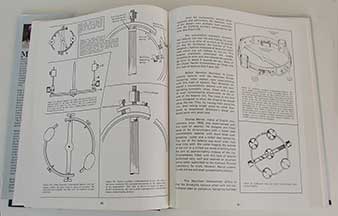 |
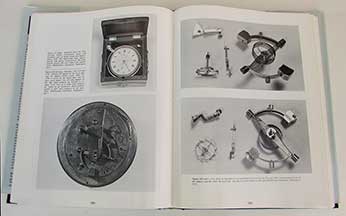 |
| plate 1 | plate 2 |
5.21/13.01 IMPORTANT CLOCK from U.S. NAVY MONITOR. Extremely rare, identified engineroom clock from the American Naval monitor the U.S.S. TERROR. This imposing timekeeper is made of heavy solid bronze. The early form pressed copper dial is silvered with bold Roman numerals and a minute chapter ring. The ship's name USS TERROR is prominently engraved just below the center arbor. The case maker's name "ASHCROFT MFG CO. New York" is just below. At the top, below XII is the Fast/Slow adjustment and below it is the subsidiary seconds bit indicating single seconds marked by 15's. The dial is swept by large blued steel Breguet style "moon" hands. The silvered dial shows some authentic wear. The word "ENGINE ROOM" is stenciled on the dial -- faint but still visible. Importantly the dial is original and has not been retouched or modified. The classic flared ship's clock case is hinged on the left, opening to the right, closing on a skeleton key lock which retains its original key. The mechanism is the best ship's clock ever made in America by the Howard Clock Company of Boston. It features a bi-metallic balance, 11 jewels, 8-day spring barrel and lovely damascened nickel plates. It is signed "E. Howard & Co. Boston" and is serial numbered "17." The very low number indicates it was one of the first ship's clocks ever produced by Howard, soon after the Civil War. The massive solid bronze case, produced by the Ashcroft Steam Gauge & Valve Co. has an 8 1/4 inch dial and a case flange of 10 ¾ inches, It measures 4 inches deep and weighs an impressive 15 pounds! It is in excellent original condition and is a strong runner after 150 years! USS TERROR (BM-4) TERROR was an AMPHITRITE class monitor with twin screws and double turrets. She displaced 3,990 tons with a length overall of 263 feet, a beam of 55 ½ feet and a draft of 14 feet 8 inches. In 1874, nine years after the Civil War, President Ulysses S. Grant ordered it built. The contract was awarded to the William Cramp & Sons Shipyard in Philadelphia, a major builder of U.S. Navy ships at that time. Work halted in 1877, but began again 6 years later. The reasons for the delay were two fold. Firstly, there was no foundry in the United States capable of producing the heavy armament specified in the ship's plans. Secondly, advancements in Naval architecture were progressing so rapidly that innovations in design were overtaking the original obsolete specifications. Still unfinished, the massive warship was towed to the New York Naval Yard for completion. On April 15, 1896 USS TERROR was finally commissioned. Assigned to the North Atlantic Squadron, TERROR operated up and down the East Coast. When the Battleship MAINE exploded in Havana Harbor on February 15, 1898 TERROR was dispatched to Key West, Florida, arriving on April 2nd. On April 25th the United States declared war on Spain. On the very first day of hostilities TERROR captured the Cuban vessel ALMANSAS. In the following 2 days the monitor captured the Spanish ships AMROSIA BOLIVAR and GUIDO. On May 12th Admiral Sampson's squadron began bombarding the Spanish batteries at San Juan, Puerto Rico. TERROR, the fifth ship in the column, fired 31 ten inch shells in 3 salvos, scoring a direct hit on the shore battery. For the remainder of the war TERROR cruised the West Indies and the waters off Puerto Rico. Into the early 1900's TERROR served as a training ship for midshipmen at the U.S. Naval Academy. She was ultimately decommissioned on May 8, 1906 and scrapped sometime in early 1930. Edward Howard (1813-1904), apprenticed to the famous early American clock maker Aaron Willard, Jr., began his own manufacturing in Boston in 1840. His firm was known as the E. Howard Co. until 1881. The first clocks known as "marine clocks" made their appearance around 1860. All of Howard's movements were very well made. The Howard model 69 marine/locomotive clock had 11-jewels with plates of heavy brass, nickel plated and highly damascened. (Marvin Whitney, "Military Timepieces," 1992, AWI Press). Interestingly, the back of the dial of this clock is etched "U.S.S. Santee Feb 14, 1902." SANTEE was a sailing frigate of 44 guns commissioned on June 9, 1861. After active service in the Civil War SANTEE became the major training ship at the U.S. Naval Academy, Annapolis, Maryland for decades. On April 2, 1912 SANTEE sank at her mooring. The relationship between TERROR and SANTEE is unclear. More fascinating research will prove valuable. |
 |
 |
| perspective | dial |
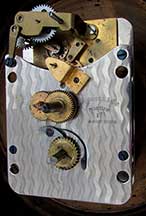 |
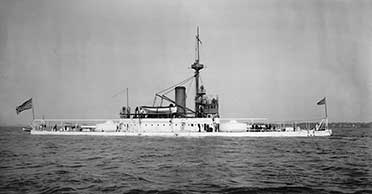 |
| movement | ship |
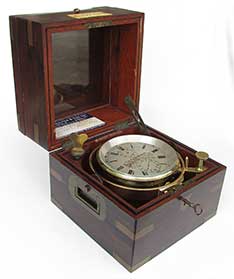 |
 |
 |
| box | front |
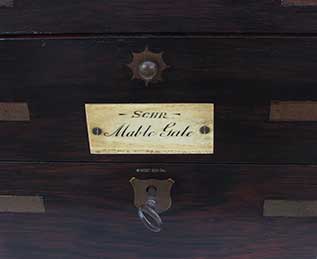 |
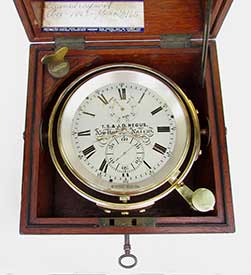 |
| mable gale | in box |
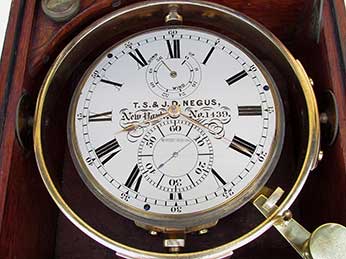 |
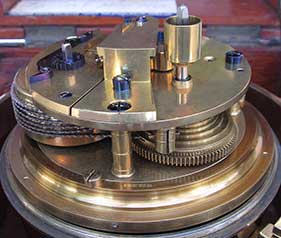 |
| dial | fusee |
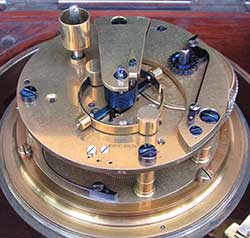 |
 |
| balance | bowl |
 |
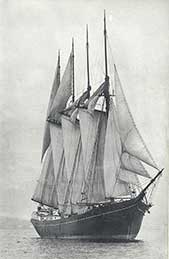 |
| ship | ship 2 |
 |
| plate |
 |
5.16/13.02 RARE AMERICAN CHRONOMETER. A scarce surviving example from a very limited production of full-sized ships' chronometers produced for the U.S Navy by the most prestigious American clock & watch company during World War II. This amazing relic is Elgin's Model 600. The silvered enameled dial is serial numbered (N) 610 dated 1943 within the seconds bit over the "6." It has bold Arabic numerals swept by blackened spade hands over a minute chapter ring. The 56 hour Up/Down is below "12" marked in 8 hour increments. The dial is signed "ELGIN U.S.A." just above the center arbor. It is surrounded by the silvered reflector ring under a beveled glass crystal set in its knurled brass bezel. Built to exacting Navy specifications the brass bowl with gimbal lock is mounted in its gimbals slung in a rich brass-bound mahogany box of classic 3-tier construction. The magnificent nickeled brass movement has 14 jewels with a large bi-metallic balance wheel, 6 timing weights and the state-of-the-art Guillimane hairspring. The unusual two-part balance bridge has a diamond end stone. The top plate is beautifully engine turned and is engraved "ELGIN 600 U.S. 14 JEWELS U.S. NAVY BU-SHIPS (N) 610, 1943." This machine is fitted with Elgin's fusee drive and innovative detachable escapement – a first in chronometer manufacturing. The handsome fully brass-bound mahogany box is equipped with 2 sliding button latches and bears the unique Elgin corking instructions on the brass plaque in the middle tier. The bottom section has folding brass drop handles for carrying. The chronometer itself measures almost 5 inches in diameter. The box measures 7 ½ inches square by 8 inches high. Condition is nothing short of remarkable in ALL respects. This chronometer shows no signs of being used since it was manufactured 79 years ago! Perfectly preserved, factory MINT original condition! ATTENTION COLLECTORS! You will not see this type of offering again! Elgin's number 1 chronometer is in the Smithsonian Institution.Price Request Marvin Whitney in his monumental reference book, "Military Time Pieces." 1992, American Watch Makers Institute, devotes an entire chapter to "Ship's Chronometer Elgin." In it he writes, "Shortly after the attack on Pearl Harbor, the Elgin National Watch Company devoted their entire production facilities to the war effort. When the United States entered into World War II, our source of marine chronometers from Switzerland was immediately cut off. Up until that time, the world navies depended upon Swiss and English manufacturers. The Hamilton watch Company was the first to produce a ship's chronometer that met Navy specifications. In order to prevent a recurrence of the critical shortage, Elgin was awarded a contract in 1943 for 3,000 chronometers. On February 15, 1944 Elgin delivered their prototype chronometer to the Naval Observatory. The last shipment of chronometers was received on May 31, 1945. Shortly thereafter the war ended. None of the Elgins were ever issued." In November 1956 Elgin reported it had sold approximately 250 of their model 600 marine chronometers to the public. In consideration of the fact that Hamilton made more than 12,152 Navy-type chronometers (as affirmed by serial numbers of recent sales) or a ratio of more than 50:1, this Elgin example is definitely a rarity in the realm of Navy chronometers! |
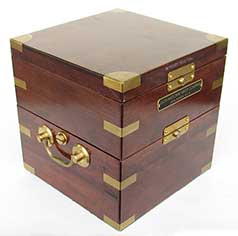 |
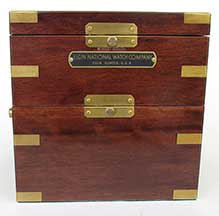 |
| BOX | FRONT |
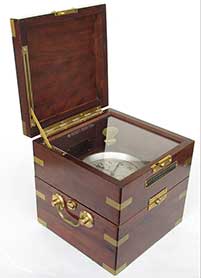 |
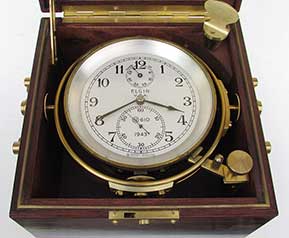 |
| OPEN | IN BOX |
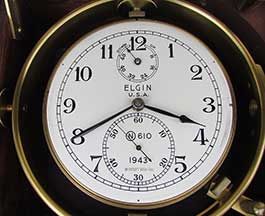 |
 |
| DIAL | MOVEMENT |
 |
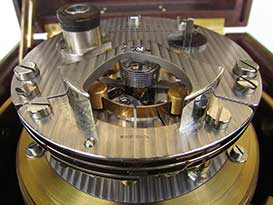 |
| FUSEE | BALANCE |
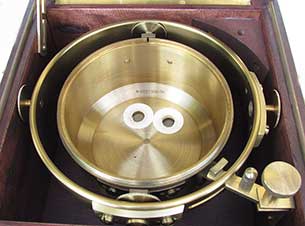 |
| BOWL |
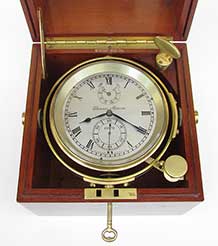
|
box |
beveled glass |
perspective |
dial |
fusee |
balance |
bowl |

|
13.00 SHIP's BELL CLOCK. A classic! Finest quality 8-day ship's bell clock made by the prestigious Chelsea Clock Company of Boston, Massachusetts. The 4 ½ inch silvered brass dial has bold Arabic numerals and a minute chapter swept by black Breguet-style "moon" hands. Below the center arbor it is marked "CHELSEA SHIP'S BELL." The dial is encircled by the silvered brass reflector ring. The screw-on brass bezel with glass provides an air tight coverning. The handsome all brass 11 jewel movement is Chelsea's 4L model, first introduced in 1950. It is marked on the back plate "CHELSEA CLOCK COMPANY, BOSTON, U.S.A." and bears the serial number 581XXX.* This dates the clock to 1953. The movement is housed in its traditional ship's clock case of solid brass with flared bezel and mounting flange. The case number matches that of the movement. It measures 5 ½ inches in diameter and 3 1/2 inches deep. Enhancing its handsome presentation the clock is mounted on a custom hardwood stand in gloss finish. It measures 9 ½ inches high by 11 ½ inches wide and is 6 ½ inches deep. The clock is a strong runner. Perfect for mantel, shelf, library or desk. Complete with period winding key 895 |
perspective |
back |
dial |
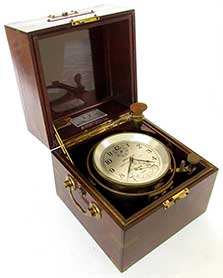
|
5.06 /13.98 U.S. NAVY CHRONOMETER. Genuine state-of-the-art full size World War II marine chronometer developed for the U.S. Navy by the "Hamilton Watch Co. of Lancaster, PA., U.S.A." as marked on the dial and on the box nameplate. This 85 size timepiece has a silvered brass dial with bold Arabic numerals and minute chapter swept by black enameled spade hands. The subsidiary seconds bit is over the "6" showing individual seconds marked by 10's. The 56 hour Up/Down indicator is below the "12." The serial number "(N)1356" and date "1941" are within the seconds bit. The heavy knurled brass bezel with thick beveled glass has a silvered reflector ring. It screws onto the solid brass bowl slung in gimbals. A spring loaded rotating dust cover protects the winding arbor. The pristine nickel movement is beautifully damascened bearing the signature "MODEL 21 14 JEWELS HAMILTON WATCH CO. LANCASTER, PNNA. MADE IN U.S.A. (N) 1356-1941." It features an oversize balance with 12 timing weights and innovative helical Elinvar hairspring. It has a spring détente escapement and a chain-drive fusee. The box is Hamilton's standard 3 tier type made of rich mahogany, fully brass-bound with inland corners in its original finish. The sides are equipped with folding brass handles and the top 2 tiers have brass button latches for secure closure. The entire unit is in untouched original condition. All brass surfaces are original showing good expected exposure to their marine environment. The surfaces of the wood are in excellent, unmarred finish. The chronometer measures 5 inches in diameter. The box is 7 5/8 inches cubed. Complete with original ratcheted winding key. An excellent time keeper. |
box |
open |
in box |
dial |
balance |
movement |
maker |

|
13.96 IMPORTANT CHRONOMETER. Very early 1800's 2-day ship's precision timekeeper by the highly respected maker "James McCabe, Royal Exchange London 357" as signed in fancy script on the silvered brass dial. This handsome timepiece has bold Roman numerals and a minute chapter swept by solid gold spade hands. The subsidiary seconds bit is over the VI showing single seconds marked by 10's. The Down/Up indicator is below XII reading 0 – 56 in 8 hour intervals. The chapter ring is marked in 5 minute intervals 5 – 60. Speaking to its age this chronometer has the early form convex glass crystal. The square bowl is slung in gimbals. The all brass movement has a top plate engraved "Jas McCabe Royal Exchange 357 LONDON." It is additionally stamped "357 IMC" on the back of the dial and "357" in the tub. The exceptionally fine movement has a large bi-metallic balance with 8 timing weights, blued steel helical hairspring and screws, diamond end stone on the balance, diamond escape wheel bearing, spring détente escapement and of course chain drive fusee. Workmanship is of the first order. The fully brass-bound box is a thing of beauty, constructed of figural crotch grain African mahogany with brass whale tail corners, fancy inlaid escutcheons and iridescent mother-of-pearl disc on the front. The disc has the unusual property of appearing to have depth. The box retains it early form brass drop handles and is complete with its original box lock, skeleton key and ratcheted winding key. The box measures 6 ¼ inches square by 6 ¾ inches high. Outstanding original condition exibiting great age. |
box |
front |
open |
in box |
crystal |
dial |
balance |
fusee |
keys |

|
13.95 RARE CHRONOMETER by IMPORTANT MAKER. Magnificent 4th quarter of the 19th century ship's 8-day chronometer with the large silvered brass dial engraved in beautiful cursive script "McLachlan, London 312." This massive timekeeping machine features bold Roman numerals with a minute chapter ring swept by solid gold hands. The large subsidiary seconds bit overlies the VI showing single seconds marked by 10's. The equally large Down/Up indicator is below XII showing 0 – 8 days. The huge bezel with silvered reflector ring is protected by thick beveled glass. It is mounted in its highly polished brass bowl slung in gimbals with pivoting gimbal lock. The massive winding key (the biggest we have ever seen) is retained in its slot at the right rear of the box. The all brass movement is a thing of beauty with highly polished damascened plates, blued steel screws, diamond end stone on the balance, spring détente escapement, innovative Palladium hairspring and of course the "bicycle chain" fusee. The complicated bi-metallic balance is that of Victor Kullberg's later form with multiple timing screws. The reverse fusee is also a Kullberg trademark. But firmly insuring this is Kullberg's output is the serial number "5273" twice stamped, once under the balance and again in the bottom of the tub, dating this chronometer to 1891. The oversize chronometer box is also a thing of beauty having been constructed entirely of the lovely ebony-like wood known a "coromandel." Only the most valuable and prized objects d'art were ever made of this extremely rare wood which is now virtually extinct. The box is complete with its skeleton key lock, blank ivory disc on the front and classic brass shield inlay on the top. Of valuable note is the fact that the glass lid in the second tier of the box is thick beveled glass. We have never encountered this feature in chronometer boxes with their original lids in our 40+ years! 8 ¼ by 8 ½ by 9 inches tall. The chronometer is just short of 6 inches in diameter. Condition, in a word, is outstanding, in all respects. Surely one of the very best we have ever had the pleasure of offering. |
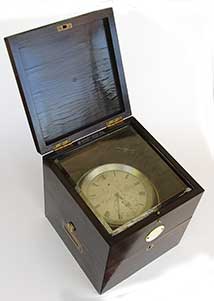 |
|
box |
open |
in box |
dial |
bowl |
bowl number |
balance |
movement |
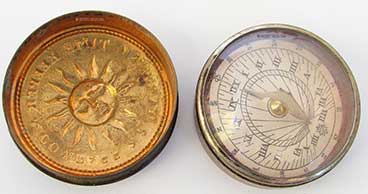
|
13.92 SUNDIAL. Genuine 19th century pocket compass and sundial of the floating gnomon type. This "automatic" time keeper features a dry compass card mounted with brass gnomon atop the gold pivot. The card is marked with hours of the day in Roman numerals sub-divided in 15 minute intervals from IV A.M. in the morning to VIII P.M. in the evening. The periphery of the card is marked with the cardinal and intercardinal points of the compass rose. It is contained within its brass housing with convex glass dome. The bottom is embossed "D. L. SMITH'S PATENT ** AUG. 23, 1870**" Ingeniously, the instrument self-aligns with magnetic north thus giving an instantaneous time reading as the sun's shadow from the gnomon falls on the card. It is complete with its press-fit brass cover embossed with a classic sunburst reading "MAGNETIC TIME KEEPER & COMPASS." 1 inch and a half in diameter! Outstanding original condition in all respects. A charming real scientific instrument which is NOT a toy. 289 |
cover |
size |
maker |
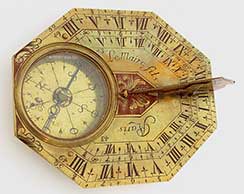
|
9.97/13.91 BUTTERFIELD SUN DIAL. An astounding offering! This is a late 16th or very early 17th century cased pocket sun dial of the type known as a Butterfield dial, invented by Britisher turned Frenchman Michael Butterfield circa 1690. This stunning surviving example is all brass made by "LeMaire Fils, Paris" as beautifully-engraved just below the compass. The very early form compass needle rides over the engraved compass rose indicating the cardinal and intercardinal points of the compass marked N, S, and O, with the north point indicated by a fleur-de-lis. The dial is constructed with a hinged gnomon, the angle of which can be adjusted for latitude as indicated by the beak of a bird on a scale reading from 40 to 60 divided in single degree increments. The upright gnomon is spring-loaded and will lie flat on the body of dial on either side. The dial plate has 3 beautifully-engraved chapter rings for latitudes of 43, 46, 49, and on the extreme periphery 52 degrees, these encompassing the area between Gibraltar and the Shetland Islands. The time indications in whole hours are marked in Roman numerals from 4 A.M. to 8 P.M. divided by 15 minute increments. The reverse of the dial is engraved with at least 23 latitudes of prominent European cities of the time. Incredibly this superb instrument comes in its original felt-lined wooden case with its durable fish skin cover, all of which are in a remarkable original state of near pristine preservation! The octagonal dial measures 3 ¼ inches long by 2 5/8 inches wide, fitting neatly in its case measuring 3 ½ inches long by 3 inches wide. The hinged lid of the case closes with a button latch, further secured by 2 hook and eye closures. A remarkable scientific instrument in unheard of original condition over 300 years old! Museum quality of the first order. 2879 |
case |
case bottom |
in case |
interior |
perspective |
bottom |

|
5.02/13.90 U.S. NAVY DECK CLOCK. World War I era ship's clock made for the United States Navy by the prestigious Chelsea Clock Company of Boston. The handsome brushed brass dial is flawless. It has bold Arabic numerals and a minute chapter swept by blackened Breguet moon hands. The dial is marked "U.S. NAVY Deck Clock No. 2" with the Naval Observatory's serial number (N) 2420. It is also marked at the bottom "Made In U.S.A." underneath the blackened brass reflector ring. The subsidiary seconds bit is below "12" indicating single seconds marked by 10's. The all brass 11 jewel 8-day movement is marked "CHELSEA CLOCK CO. BOSTON. U.S.A." and is serial numbered 122XXX* dating it to July 6, 1918. It is housed in its original classic ship's clock case of heavy solid brass with matching serial number and flared screw-on bezel. The bezel retains its original old wavy glass held in with plaster. 5 3/8 inches in diameter by 2 ½ inches thick. Outstanding condition in all respects. The clock is a good timekeeper and the case is in a lovely high luster finish. From America's dreadnaught Navy over 100 years ago! Complete with period winding key. 849 |
perspective |
dial |
movement |
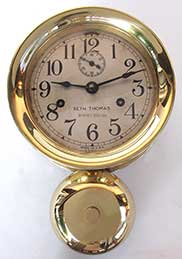
|
13.87 SHIP's BELL CLOCK. The classic American-made bottom bell clock by the venerable Seth Thomas Company as signed under the center arbor "SETH THOMAS" and marked "Made In U.S.A." under the "6." This handsome all brass ship's clock has a silvered brass dial with bold Arabic numerals and a minute chapter swept by blued steel spade hands. The subsidiary seconds bit below the "12" shows single seconds marked by 10's. Above the "12" is the Fast/Slow regulator. The "STRIKE" adjustment lever is next to the "9." The flared brass bezel hinges on the right, opening on the left with a press fit. Of great desirability is the unique exterior bottom bell which strikes the ship's bell every half hour with an amazingly loud, clear tone. This clock has just been serviced by a professional watch and clock maker and is in tip top running condition, striking the ship's bells sequence properly. 7 inches in diameter, 10 ½ inches tall and 3 ½ inches deep. Complete with period winding key. 789 |
perspective |
dial |
back |
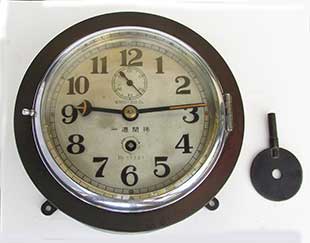
|
13.86 RARE FUSEE SHIP's CLOCK. Very unusual late 19th century ship's clock of Japanese manufacture. This rare ship's timekeeper was made by the venerable Seikosha Company of Tokyo, a branch of the famous Seiko Company, well known for its high quality clocks and watches. This early example has a silvered brass dial with bold Arabic numerals swept by blued steel hands bearing the original luminescent paint. The subsidiary seconds bit indicating single seconds marked by 10's is located below the "12." The maker's name in Japanese Kanji is just above the winding arbor. The Fast/Slow adjustment is above the "12." When the bezel is opened the bottom of the dial reads "MADE BY SEIKOSHA, TOKYO, JAPAN." The hinged bezel of nickel-silver opens on the left with a button latch. It contains a thick beveled glass crystal. The clock body is solid brass in an oxidized finish. There are 3 mounting tabs for hanging. The extremely heavy solid brass movement is a thing of Horological beauty, obviously copied after high end British clocks of the era. It is of the very finest quality with thick brass plates. The bi-metallic, temperature compensated balance is fully jeweled. The blued steel hairspring has a long compensation curb. It has numerous gold timing weights and a very unusual "L" shaped hairspring brace we have never seen before. Speaking to its quality there is a brass shield encompassing the spring barrel for safety lest the fusee chain gives way. The plates are attached in the early manner using taper pins rather than screws. Of further significance is the fact that the platform is totally protected by a rectangular brass cover. Uniquely, the backplate of the movement is equipped with 2 turned nickel "feet" allowing it to stand on its own for inspection and servicing. The back of the clock case is painted with an inscription in Kanji. More research could render additional provenance. Beautiful original condition overall. This clock keeps excellent time, having been recently serviced by a professional watchmaker. Complete with original, very large and unique winding key. 989 |
dial |
back |
movement |
escapement |
escapement cover |
BARREL SHIELD |
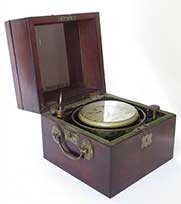
|
13.63 VERY IMPORTANT EARLY CHRONOMETER. Special, second decade of the 1800's early ship's time keeper from the age of sail, made by one of the most respected and award winning makers of his time, "James Murray, Royal Exchange, London, No. 673" as beautifully engraved in script on the silvered brass dial. This early 2 day machine, made by the master, is a thing of beauty. The dial is marked with the traditional bold Roman numerals and minute chapter ring. The single seconds subsidiary dial is above the VI. Attesting to its early origins the Up/Down indicator is calibrated from 0 – 48, not 0 – 56 as in later chronometers. The dial is swept by solid gold spade hands. The instrument is house in its solid brass bowl with rotating dust cover, slung in gimbals with traditional style English gimbal lock. It is complete with its' original ratcheted chronometer winding key. Also telling of it early age is the fact that this chronometer is housed in it original plain mahogany box of 3-tier construction with brass inlays. The lower section is equipped with the very early-form felt-lined dust barrier. The movement itself is a thing of beauty. The unusually small movement (typical of 1800-1820) with diamond end stone has a polished back plate bearing the beautifully-engraved inscription "James Murray Royal Exchange, London No 673" with great flourishes. The complex bi-metallic balance has an unusually large number of timing weights and a blued steel helical hairspring. The movement is of the spring detent type with chain-drive fusee. This chronometer is in outstanding original cosmetic and functional condition. The diminutive movement measures 4 ¼ inches in diameter. The dial is 3 ¾ inches across. The box measures 6 ¾ inches cubed. Complete with its original ratcheted winding key. Certainly one of the finest chronometers we have ever had the pleasure of offering. Without question a museum piece. Price Request |
perspective |
detail |
dial |
movement |
upper lid |
box |
Order Info
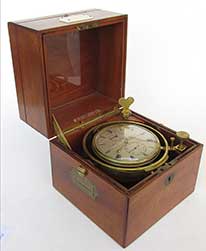
|
13.85 WINNING CHRONOMETER. Second quarter of the 1800's two day marine chronometer by the very famous London makers "Robert Molyneaux & Sons No. 1558, LONDON " as beautifully engraved in cursive script on the silvered brass dial. This handsome navigational timekeeper is the early 2-day type with Up/Down indicator reading from 0 (Up) to 54 (Down). It has bold Roman numerals and a minute chapter swept by lovely solid gold spade hands. A large subsidiary seconds bit is just above the VI. It indicates single seconds marked by 10's. The prefect dial is protected by the classic domed glass crystal with thin knurled brass bezel. The early movement is a thing of beauty having a bi-metallic balance with large segmental pie-shaped weights, blue steel helical hairspring, diamond end stone, blued steel screws, spring détente escapement and of course a chain-drive fusee. It is slung in its solid brass tub mounted in gimbals, with thumbscrew locking lever in the front right of the box. The handsome 3-tier box of crotch grain African mahogany is of simple form, indicative of its early manufacture. It has an inlaid ebony dust combing in the bottom tier and is complete with its early form ratcheted "butterfly" winding key. The front bears a large blank ivory nameplate and starburst inlays around the key escutcheon and button latch. The top lid is inlaid with a classic brass shield. The sides have inlaid flush folding brass carrying handles. This chronometer measures exactly 4 ½ inches in diameter. Its box measures 7 3/8 inches wide and 7 1/8 inches deep by 7 7/8 inches high. Outstanding original condition is all respects. The chronometer is a strong runner and keeps good time. Circa 1833. Price Request |
perspective |
box |
open |
christies |
in box |
dial |
movemenT |
balance |

|
5.93/13.84 U.S. NAVY PT BOAT WATCH. The famous World War II 35 size chronometer watch Model 22, made by the "Hamilton Watch Company of Lancaster, PA, U.S.A." for the U.S. Navy as marked on the white enameled dial. This state-of-the-art timekeeper was issued to Navy PT Boats and other ocean-going craft requiring accurate "over the horizon" coastal navigation. It is the exact type of watch used on Lieutenant Kennedy's famous "PT-109." It features Arabic numerals, subsidiary seconds bit, blued steel hands, and an UP/DOWN winding indicator showing a 56 hour duration. It is stem wound and pin set, meaning it has an innovative safety feature at the 11 o'clock position -- a pin which must be depressed in order for the watch to be set. The lovely state-of-the-art 21 jewel movement with damascened nickeled brass plates is marked "HAMILTON WATCH CO., Model 22 - 21 Jewels, Adj. to Temp. and 6 Pos., Made in U.S.A., U.S NAVY BU. SHIPS-1942." It is contained within its original base metal case marked "KEYSTONE" with protective snap fit inner dust cover and outer screw-on cover engraved "BUREAU OF SHIPS U.S. NAVY N4927-1942 CHRONOMETER WATCH." This deck watch is housed in its original padded solid mahogany 2-tier chronometer watch box with viewing port and button latch. It measures 5 by 6 inches and 2 inches thick. It is in absolutely lovely condition inside and out and is an excellent time keeper. |
open |
watch |
dial |
back |
movement |

|
detail |
side |
back |
dial |
movement |
sound board |

|
13.77 RARE CHELSEA CLOCK. Scarce, downright rare miniature bulkhead clock made by the prestigious Chelsea Clock Company of Boston. The silvered brass dial is marked with bold Roman numerals and a minute chapter ring swept by blackened steel spade hands. The subsidiary seconds bit is calibrated in single seconds marked by 10's. The dial is marked with the company logo "CROSS" with elongated letters. In an unusual departure from its standard configuration the movement is held into its case with a knurled reflector ring which is threaded into the case! This reveals the diminutive early gold washed Chelsea movement signed "CHELSEA CLOCK CO. BOSTON U.S.A." The serial number 39XXX* matches the case number, dating this clock to 1913. The solid brass case is the flared ship's clock type and retains its original nickel finish. The screw-on bezel retains its original old wavy glass and turns on and off easily providing an airtight fit. 3 7/8 inches in diameter and 1 7/8 inches thick. Outstanding original condition in all respects and an excellent time keeper. Complete with original early Chelsea "butterfly" winding key. They don't get any better than this! 895 |
perspective |
knurling |
dial |
movement |

|
13.65 SHIP’s BELL CLOCK. Genuine turn-of-the-last-century American ship’s bell clock by the venerable SETH THOMAS clock company as prominently marked on the dial between the two winding arbors. It is further marked “MADE IN U.S.A.” below the “6.” This handsome clock features a silvered brass dial with bold Arabic numerals and a minute chapter ring swept by blued steel spade hands. The subsidiary seconds bit showing single seconds marked by 10’s is set below the “12.”. A manual “STRIKE” lever is provided at the “9” o’clock position to set the bell sequence and the Fast/Slow lever adjustment is also just below the “12.” The classic flared ship’s clock case has a hinged bezel with its original glass crystal hinging on the right, opening and closing on the left with a press fit. The lovely solid brass case contains a screen on the bottom to emit the sound produced by the internal brass bell. The clock strikes the ship’s clock sequence properly with a loud, clear tone. The tone is especially rich because it is made on an actual bell and not a gong as in many other “bell” clocks. 7 inches in diameter by 4 ¼ inches deep. Cosmetically fine condition. The case is flawless. The silver dial has just enough wear and patina to belie its 100+ year old age. Runs approximately 2 days on a single wind. Complete with period winding key. 595 |
perspective |
dial |
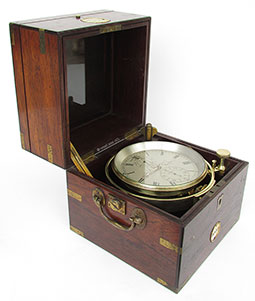
|
13.60 EARLY 8-DAY CHRONOMETER by FAMOUS MAKER. Without question, one of the finest chronometers offered for sale in the world today. This impressive marine timekeeper was made by “A. Johannsen 147 Minories London” as beautifully engraved in fancy script. The large silvered brass dial has bold Roman numerals and a minute chapter. The oversized subsidiary seconds bit is over the VI indicating single seconds marked by 10’s. Within, it bears the mark “No. 1040.” At the top, under the XII, the ~UP~ DOWN winding indicator is marked 0 to 8 and reads “WIND” at the 7 sector. The dial is swept by magnificent solid gold spade hands. The circumference has a silvered reflector ring protected by a thick beveled glass crystal. It is set in a knurled brass bezel. Unscrewing the bezel reveals the massive movement within. It has decoratively engine-turned plates, a large bi-metallic balance with timing weights, blued steel helical hairspring, diamond end stone, spring détente escapement, and of course a chain drive fusee. Interestingly the balance is protected by a crescent-shaped shield which would prevent this delicate and complicated piece of machinery from being damaged should the chain let go. The movement is housed in its beautiful bright brass bowl slung in gimbals and mounted within its large brass-bound solid rosewood box. The bottom of the bowl contains a spring-loaded winding dust cover. The classic oversized 3-tier box contains the pivoting gimbal lock on the right front and the original ratcheted chronometer winding key on the rear bottom tier. It is complete with brass skeleton lock and inlaid ivory number disc engraved with the matching serial number “1040.” The middle tier is glazed on top and bears the inlaid ivory marker’s disc on the front engraved “A. Johannsen LONDON.” A star burst escutcheon encircles a button latch which engages the solid rosewood lid with brass inlay. Both upper tiers are fitted with lid stops. The sides of the lower box have stout folding brass drop handles for carrying. The chronometer itself measures 5 ¾ inches in diameter. The box is 8 by 8 inches and is 8 ½ inches tall. Excellent original condition throughout and an excellent timekeeper. SOLD |
perspective |
box |
open |
dial |
movement |
fusee |
bowl |

|
13.58 CHRONOMETER WATCH. The famous World War II era American deck watch made for the U.S. Navy by "Hamilton Lancaster, PA., U.S.A." as marked on the white enameled dial. It features blued steel spade hands with Arabic numerals, minute chapter and an individually marked seconds bit at the "6" o'clock position. A 56 hour winding indicator just below the "12" indicates "Up/Down," and is marked in 8 hour increments from "8-48." This finest quality ship's time keeper is embodied in a state-of-the-art 35 size, 21 jewel movement with lever escapement, stem wound and safety pin set. The damascened nickel-plated brass movement is a thing of beauty. It is engraved, "Hamilton Watch Co. Model 22-21 jewels Adj. to Temp 6 Pos. Made in U.S.A. U.S. Navy Bu Ships-1942." It is contained within its heavy, solid brass tub with substantial brass counterweight, suspended in gimbals. The gimbal assembly functions properly and can be locked by a thumbscrew and lever inside the box. The 3-tier solid mahogany box has a glazed middle section bearing an instruction plate concerning setting the watch. The top has a solid mahogany lid. Both sections are hinged with clever box lid stops to hold the upper portions in place when opened. Each contains a nickeled brass button latch which opens and closes easily providing a secure closure. The front bears the nickeled brass maker's plaque reading, "Hamilton Watch Co. Lancaster, PA., U.S.A." The entire unit is in remarkably pristine condition. The watch is an excellent timekeeper having just been professionally serviced by a certified AWI watchmaker and is in top running condition. Making this presentation all the more desirable is the fact that it is housed within its outer protective carrying case with original leather strap. The front of the outer box also bears Hamilton maker's plaque and is complete with hook and eye closure. The outer box is in absolutely pristine condition as well. We have seen scores of these in our tenure. This is the best one we have ever seen! Price Request |
outer box perspective |
outer box |
in outer box |
outer box open |
bowl |
dial |
inner box |
lid open |
in box |
movement |
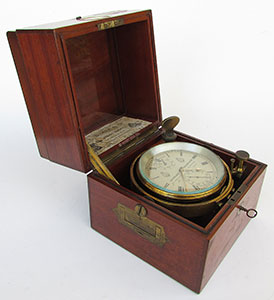
|
perspective |
box |
handle |
open |
in box |
dial |
movement |
top plate |
balance |
fusee |
compensation |
awards |
label |
ship |

|
13.49 ROYAL NAVY RESEARCH CHRONOMETER. Very scarce 2-day marine chronometer made by the venerable English chronometer making firm of Thomas Mercer for the Royal Navy as boldly engraved on the silvered brass dial. It reads, “20134 THOMAS MERCER ADMIRALTY NO: 6472.” Then at the VI o’clock position it is engraved “Thomas Mercer Ltd. St. Albans Eng.” This handsome marine timekeeper has bold Roman numerals and a minute chapter swept by particularly beautiful blued steel spade hands. The standard 2-day (56 hour) Up/Down indicator is below the XII. The subsidiary seconds bit below the center arbor shows single seconds marked by 10’s. In a very unusual departure from most chronometers the seconds wheel and components of the movement are visible through a “window” in the center of the seconds bit! This chronometer has the rare feature of being a “break circuit” type, meaning it was used in hydrographic survey applications when sightings needed to be timed and/or coordinated. To these ends a small electrical détente is positioned on the seconds wheel to detect the precise passage of each minute of time. The window then, allows the observer to directly view the workings of this electrical take-off feature. The dial is protected by its heavy brass bezel with silvered reflector ring and beveled glass. The all brass jeweled movement is a thing of beauty with decoratively-spotted plates and balance cock, diamond end stone, a large compensated bi-metallic balance with timing weights, helical Palladium hairspring, spring détente escapement and of course a chain drive fusee. The movement and bowl are stamped with matching numbers “20134.” As mentioned, this chronometer has an electrical take-off feature which is in evidence on the reverse side of the dial where contacts meet the interior of the bowl and lead to the exterior of the tub. There, they stand as insulated terminals with knurled screws for attachment to wiring. The heavy brass tub is complete with its protective spring-loaded winding dust cover on the bottom and its original gimbal. The exposed brass surfaces retain about 90% of their original protective orange lacquer. This chronometer is in excellent overall cosmetic and running condition. A real rarity at a very real low price. 2500 |
FUSEE |
MOVEMENT |
BOWL |
CONTACTS |
TERMINALS |
TUB |

|
box |
open |
in box |
dial |
bowl |
fusee |
balance |
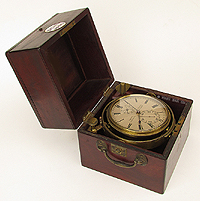
|
13.32 IMPORTANT CHRONOMETER. Most desirable 2-day marine chronometer by one of England’s finest and most revered horologists. This is John Edward Dent marine chronometer number 1590 as signed on the silvered brass dial “DENT LONDON 82 Strand No. 1590” and again on the porcelainized nameplate on the front of the box, “DENT 1590.” The immaculate dial, unusually large for this type of configuration, features bold Roman numerals and a minute chapter swept by delicate blued steel hands. The subsidiary second bit is below XII and indicates 0 – 56 hours with the unusual additional markings of “UP, WIND, 2 DAYS, and DOWN.” It is protected by the early form domed glass crystal with thin brass bezel. The movement is housed in its gimbaled brass bowl with locking lever at the left rear and original ratcheted winding key, twice marked “1590,” on the right. The magnificent all brass movement is a thing of beauty, with decoratively-spotted shiny brass plates, turned brass pillars, large bi-metallic balance with early form pie-shaped segmental timing weights, blued steel helical hairspring, diamond end stone in the balance cock, highly blued steel parts, spring détente escapement, and of course a chain drive fusee. The inside of the bowl is stamped “DENT” and “1590.” The exterior bottom of the bowl exhibits a very unique dust cover over the winding arbor. It consists of a spring-loaded lever with cap covering the aperture. This is a much more complex feature over the typical rotating disc found on virtually all other chronometers. The simple crotch grain African mahogany box is indicative of early 1800’s chronometers. It has folding drop handles on each side and an inlaid brass key escutcheon in addition to the previously mentioned maker’s plaque. This extremely rare navigational timepiece measures a diminutive 6 ¼ inches cubed. The unusually large dial measures 4 inches in diameter. Absolutely outstanding condition in all respects. It is a strong runner and is virtually perfect cosmetically. Circa 1842. Price Request Edward John Dent (1790-1853) was certainly one of the preeminent English horologers in the first half of the 1800’s. During his very productive life he set up a large number of factories and workshops turning out his inventions and products. According to Tony Mercer in “Chronometer Makers of the World,” Dent began his business career in 1814 at 64 the Strand and 28 Cockspur Street in London. He moved to 84 the Strand in 1840. In 1828 his chronometer No. 114 won the Premium Trails at Greenwich. This fact caught the eye of pioneer chronometer maker John Roger Arnold who took Dent in as a partner in 1830. The chronometer making partnership lasted 10 years. Following their partnership Dent moved to 84 the Strand in 1840. A number of Dent’s chronometers accompanied famous expeditions to both Polar regions and the tropics. No. 1800 accompanied David Livingston during his African explorations. In 1841 Dent was granted the Royal Warrant as “Chronometer Maker to the Queen and the Prince of Wales.“ Among his achievements beyond chronometer making, Dent was the maker of the famous “Big Ben” Parliamentary tower clock in London. He designed and produced a very early form of aneroid barometer (without liquid) which revolutionized barometers at sea. He also invented and produced his patented dipleioscope which used the sun’s rays to determine local apparent noon for the purpose of accurately setting watches of the era. |
box |
perspective |
open |
detail |
dial |
movement |
fusee |
dust cover |
dust cover open |
inside bowl |
key |

|
13.99 WW I TORPEDO BOAT CHRONOMETER WATCH. Rare marine chronometer watch manufactured by the highly respected Swiss firm of "LONGINES, SWISS" as marked on the perfect silvered dial. This large timekeeper in pocket watch format features a snap fit bezel with glass crystal covering a bold Roman numeral dial. The pristine dial has a minute chapter and inset seconds bit at the bottom with a 36 hour Up/Down below XII. The double hinged back cover is stamped "0.800" fine silver and opens to reveal the exceptional 17 jewel movement with decoratively damascened plates. It is stem wound, stem set, with a lever escapement and compensated balance. The movement is signed, "17 JEWELS ADJ. LONGINES Co. Swiss." This high grade deck watch is housed in its original satin-lined mahogany inner box with splined construction and brass closures. As a collectible, what is exceptional is the fact that it is complete with its outside carrying box with padded green felt interior and original leather carrying strap. The watch itself has a dial 2 ¼ inches in diameter. The solid silver case is 2 ¾ inches in diameter and 3 ¾ inches high inclusive of the bow. The inner case measures 5 by 6 by 2 1/8 inches. The outer case is 9 ¼ inches wide, 8 ½ inches long and 6 inches high overall. The entire offering is in beautiful original condition and the watch is an excellent timekeeper. Price Request |
perspective |
outer box |
outer box open |
inner box |
in box |
inner box open |
watch |
dial detail |
movement |
0.800 |
case |

|
13.88 MINT CHELSEA CLOCK. An amazing find! Offered here is an older large Chelsea ship’s bell clock in unused, factory mint condition -- still in its original presentation box! This is an 8 ½ dial ship’s bell clock featuring a silvered brass dial with large Arabic numerals and a minute chapter ring swept by Breguet-style blued steel “moon” hands. The dial is marked “CHELSEA SHIP’S BELL” between the two winding arbors and the Fast/Slow micrometer adjustment is at the 9 o’clock position. It is complete with the silvered brass (not plastic) reflector ring encircling the dial. The high quality 11 jewel movement is Chelsea’s finest quality all brass ship’s bell type with lever escapement made in America. The massive brass case is of the classic ship’s clock type with flared bezel, hinged on the right, opening and closing with a button latch on the left. The case number XXXXXX* matches the movement number, dating the clock to the early 1990’s. The case measures 10 1/8 inches in diameter on the bezel, 10 ½ inches wide on the mounting flange and is 4 inches deep. This clock comes complete in its original box with felt-covered foam rubber padding measuring 12 ½ by 14 inches and 5 ½ inches thick. The entire presentation weighs nearly 19 pounds! Complete with original Chelsea-marked winding key. Price Request * For the privacy of the ultimate purchaser the serial number is being withheld. |
BOX |
CLOCK |
PERSPECTIVE |
DIAL |
BACK |
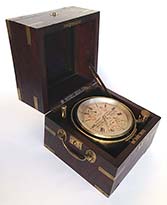
|
13.69 ENGLISH CHRONOMETER. Elegant 3rd quarter 19th century 2-day marine timekeeper by the respected nautical instrument maker “JOSEPH SEWILL 61 South Castle STRT LIVERPOOL.” as prominently engraved on the silvered brass dial. It is additionally marked in fancy script, “Maker to the Admiralty” and number “4030” within the extra large seconds bit over the 6 o’clock position. The especially handsome dial is adorned with 2 prize medal emblems from 1862 and the International Exhibition of 1867. Both are accentuated in red, as is the address “30 Cornhill London.” The 12 hour dial features bold Roman numerals with a minute chapter marked in 5’s, swept by solid gold spade hands. The subsidiary seconds bit is sub-divided into single seconds marked by 10’s. The 56 hour Up/Down indicator is located below the “XII.” The dial is covered by the beveled glass crystal set in a heavy brass bezel with silvered reflector ring. It is housed in its solid brass bowl with rotating winding dust cover on the bottom, slung in gimbals with knurled gimbal lock. The particularly lovely all brass movement with diamond end stone and blued steel screws exhibits highly polished plates with decorative engine turning. The large compensated bi-metallic balance has a blued steel helical hair spring, a spring détente escapement and a chain drive fusee. Both the tub and the back plate are stamped with the serial number “2297” indicating it was one of Sewill’s earlier movements, circa 1868, ultimately finished and sold by his son, John. This would explain the placing of the 1867 medallion on the dial and the addition of the later 30 Cornhill address within the seconds bit. The entire assembly is housed in its exquisite, fully brass-bound box of solid rosewood with brass furniture. The box measures 7 ¼ inches cubed and the dial is 4 inches in diameter, sight. Complete with its original ratcheted chronometer winding key. Excellent original condition in all respects and an excellent time keeper. |
box |
front |
open |
perspective |
detail |
dial |
movement |
fusee |
bowl |
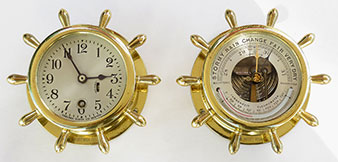
|
13.82 CLOCK and BAROMETER SET. Charming, near miniature clock and matching barometer pair made by the prestigious Chelsea Clock Co. of Boston. This matched set is absolutely of the finest quality to be found. Known as the "Manhattan" model it consists of Chelsea's high grade, jeweled time only clock having a silvered brass dial with Arabic numerals and blued steel spade hands. With a serial number of XXXXXX* this set can be dated to precisely to November 9, 1939. The matching barometer, made by Paul Naudet of Paris is marked "Made In France PNHB Compensated, Holosteric Barometer." It features a very high quality movement with an open face silvered dial calibrated in inches of mercury from 27.7 to 31.3 in 5/100th increments. It bears the standard weather indications, "RAIN, CHANGE, FAIR," etc. and is equipped with a delicate blued steel indicator needle and a brass set needle attached to a knurled knob running through the crystal. The bottom of the dial is fitted with a gracefully curving Fahrenheit thermometer calibrated in 2 degree increments from -6 degrees to 156! Both units are housed in their original heavy solid brass cases with10 decorative ship wheel "spokes" and knurled screw-on bezels. Each unit measures 4 3/4 inches in diameter overall with a 3 3/4 inch diameter mounting flange. The dials are 2 5/8ths inches across each. The 8 day clock is a good timekeeper and is complete with the original Chelsea-marked winding key. The barometer/thermometer functions are working and accurate. Outstanding cosmetic condition throughout! Request Price |
clock |
barometer |
backs |
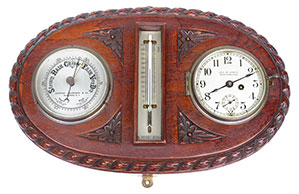
|
13.41 CLOCK / BAROMETER/THERMOMETER SET. Extremely attractive, very scarce turn-of the 1900’s, genuine ship Captain’s cabin presentation featuring a high quality clock, barometer and thermometer mounted in a heavy, superbly-carved solid mahogany mount with a classic ropework border. This set consists of 3 instruments. The left side is an aneroid barometer reading atmospheric pressure from 26.5 inches of mercury to 31.5, calibrated by 2/100th inch increments. The fancy Victorian dial is marked with the standard weather indications “Stormy, RAIN, Change, FAIR, Very Dry” with explanations on foretelling the weather by “RISES” and “FALLS.” It is signed “Simpson Lawrence Co., Glasgow.” The fine blackened steel indicator needle is overlaid by the brass set needle which is connected to a knurled brass knob rove through the beveled glass crystal in its brass bezel. The center item is a mercury thermometer calibrated from 0 to 120 degrees Fahrenheit in 2 degree increments. The clock function is of the very highest order, made by the prestigious Chelsea Clock Company. It too has a beveled glass crystal in a brass bezel hinged on the left, opening on the right with a spring latch to allow access for winding and setting. The clock has a silvered brass dial with Arabic numerals and minute chapter swept by blackened steel spade hands. The subsidiary seconds bit covering the “6” shows single seconds and is marked “CHELSEA.” The retailer, “Joseph Jones, New York, U.S.A.” is identified above the center arbor. This clock is an accurate timekeeper and runs 8 days on a single winding. Complete with period Chelsea-marked winding key. This lovely presentation measures 15 inches wide by 9 inches high and 2 ¾ inches thick. Attesting to its shipboard use, brass mounting brackets are present top and bottom to fasten it securely to the bulkhead. The carving of this set is of the first order, obviously done by a skilled ship carver. This is a very rare ship Captain’s cabin item of unsurpassed quality -- certainly one of the finest we have seen in our 35 years. The best! 2195 |
BAROMETER |
CLOCK |
THERMOMETER |
SURFACE DETAIL |
BACK |
TYPICAL CABIN |
13.21 EARLY SHIP'S BELL CLOCK. Genuine early 1900's American ship's bell clock made by Seth Thomas of Thomaston, Connecticut. This quality ship's clock has a silvered brass dial with bold black Roman numerals, blued steel spade hands, minute chapter ring and a seconds bit showing individual seconds below "XII." The dial is signed "SETH THOMAS" between the two winding arbors and is further marked "Made In U.S.A." below "VI.". The Fast/Slow adjust lever is above the 12 o'clock position and the manual strike lever marked "Strike" is left of "IX." The glazed hinged bezel with reflector ring opens from the left with a tight press fit. The case is the classic ship's clock type with flared bezel and is all brass in its original nickel finish. There is a screen at the bottom of the clock which allows maximum bell sound and it does so, ringing the ship's bell sequence properly with a loud, clear tone. The clock has just been thoroughly overhauled by a professional AWI-certified watchmaker and is in tip top condition. It is considered a 48 hours type. But in our possession since servicing, it has run 4 days on a single winding. 7 inches in diameter and 4 inches deep. Circa 1910. Excellent original condition showing wonderful age and absolutely no abuse. 495 |
PERSPECTIVE |
BOTTOM |
Order Info
13.56 YACHT WHEEL CLOCK. Certainly one of the most recognizable and most sought after clocks ever made! This impressive ship’s bell clock was manufactured by the prestigious Chelsea Clock Company of Boston for the retailers “BROCK AND COMPANY” as engraved on the silvered brass dial. Known as the “Mariner,” this clock contains Chelsea’s high quality jeweled ship’s bell movement with a 6 inch dial, Arabic numerals, minute chapter, blackened steel Breguet-type “moon” hands and reflector ring. The enduring appeal of this clock is in its magnificent presentation. It has a classic ship’s clock case with flared bezel hinging open with a spring-loaded button latch. That solid brass case is then encircled by a massive bronze “ship’s wheel” with ten turned brass spokes. It sets atop a graceful heavy bronze plinth mounted to a solid mahogany backboard and base. The entire presentation weighs an astounding 25 pounds and measures 17 ¼ inches high overall! The bezel of this clock is 7 ¼ inches in diameter and it measures 14 inches wide from spoke to spoke, while the base is 12 ¼ inches wide by 5 3/8 inches deep. With a serial number of XXXXXX* this clock dates to 1956. It is in excellent running condition and is a good time keeper, striking the ship’s bell sequence properly with a clear sonorous tone. It is in excellent cosmetic condition, exhibiting only minor wear to the dial, well expected after more than a half century of use. Complete with original Chelsea-marked brass winding key. Request Price ![]()
Brock and Company was a prominent, nationally recognized jewelry firm, certainly the most important jewelry store in Los Angeles. Brock's was founded by George A. Brock in 1903. In growing the company, Mr. Brock merged a number of other established Los Angeles jewelers into Brock & Company, including S. Nordlinger & Son, which had operated in Los Angeles since the late 1800's. In the 1920's, George Brock obtained a 99-year ground lease on the property at 515 West Seventh Street, and soon the custom-designed structure (now housing Seven Grand) was built.
With son George C. Brock at the helm, the company continued to grow. A second store was opened on Wilshire Boulevard, in Beverly Hills. At that time Tiffany and Co. even proposed the merger with Brock of "Tiffany-Brock & Co." However Brock's valued their independence and the merger did not take place.
In the early 60's, George C. Brock decided to retire. Ben Weingart, a young real estate broker in the 1920s, had been involved in the 99-year ground lease for the Brock & Co. parcel on Seventh Street. He approached Brock about purchasing some land owned by the company. Mr. Brock told Weingart that the only way he could acquire the land was to buy the company.
Mr. Weingart did just that, purchasing the single remaining Brock & Co. store downtown in 1964. Thereafter Mr. Weingart brought in a liquidator who operated the business for a few years, gradually selling off its inventory. The jewelry business ended, and some of the store fixtures were sold. Clifton's rented the building installed a cafeteria. George C. Brock died in 1967.
Originally offered as the “Yacht Wheel Clock with Base” in 1906, Chelsea gave this configuration its own identity as the “Mariner” in 1928. The model was ultimately discontinued in 1984.

